
< Go back to Login
Forgot Password
Please enter your registered email ID. You will receive an email message with instructions on how to reset your password.

Our extensive collection of Synopsis PPT templates promote productivity and convenience when it comes to its applications. These templates have been thoughtfully designed to ensure maximum visual impact. Explore our collection of Synopsis presentation templates and download the perfect template to take your presentation to new heights!
- Lessons Learned List - 4x3 – $6.99
- Lessons Learned List - 16x9 – $6.99

Lessons Learned List PowerPoint Template
Lessons Learned List PowerPoint Template Lessons Learned List PowerPoint template helps you in capturing and showcasing the valuable insights gai....
- Conclusion Slide 04 - 4x3 – $4.99
- Conclusion Slide 04 - 16x9 – $4.99

Conclusion Slide 04 PowerPoint Template
Conclusion Slide 04 Presentation Template Use this Conclusion Slide 04 PowerPoint template to create visually appealing presentations in any prof....
- Conclusion Slide 02 - 4x3 – $4.99
- Conclusion Slide 02 - 16x9 – $4.99

Conclusion Slide 02 PowerPoint Template
Conclusion Slide 02 Presentation Template Use this Conclusion Slide 02 PowerPoint template to create visually appealing presentations in any prof....
- Conclusion Slide 10 - 4x3 – $4.99
- Conclusion Slide 10 - 16x9 – $4.99
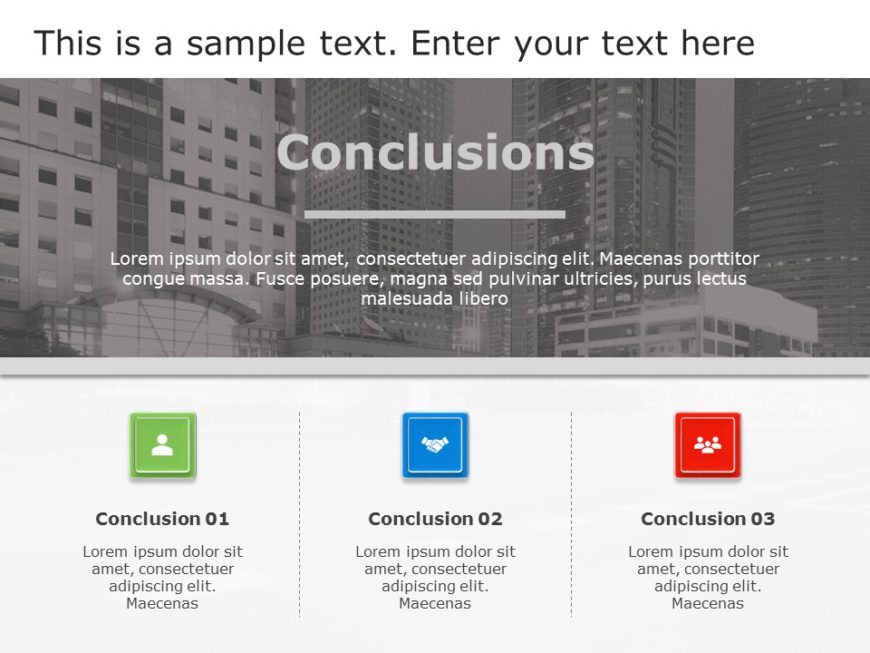
Conclusion Slide 10 PowerPoint Template
Conclusion Slide 10 Presentation Template Use this Conclusion Slide 10 PowerPoint template to create visually appealing presentations in any prof....
- Conclusion Slide 03 - 4x3 – $6.99
- Conclusion Slide 03 - 16x9 – $6.99

Conclusion Slide 03 PowerPoint Template
With this template, you can summarize or conclude the critical points in your presentation. You can leave a lasting impression on your audience b....
- Conclusion Slide 01 - 4x3 – $4.99
- Conclusion Slide 01 - 16x9 – $4.99

Conclusion Slide 01 PowerPoint Template
Conclusion Slide 01 Presentation Template Use this Conclusion Slide 01 PowerPoint template to create visually appealing presentations in any prof....
- Conclusion Slide 13 - 4x3 – $4.99
- Conclusion Slide 13 - 16x9 – $4.99
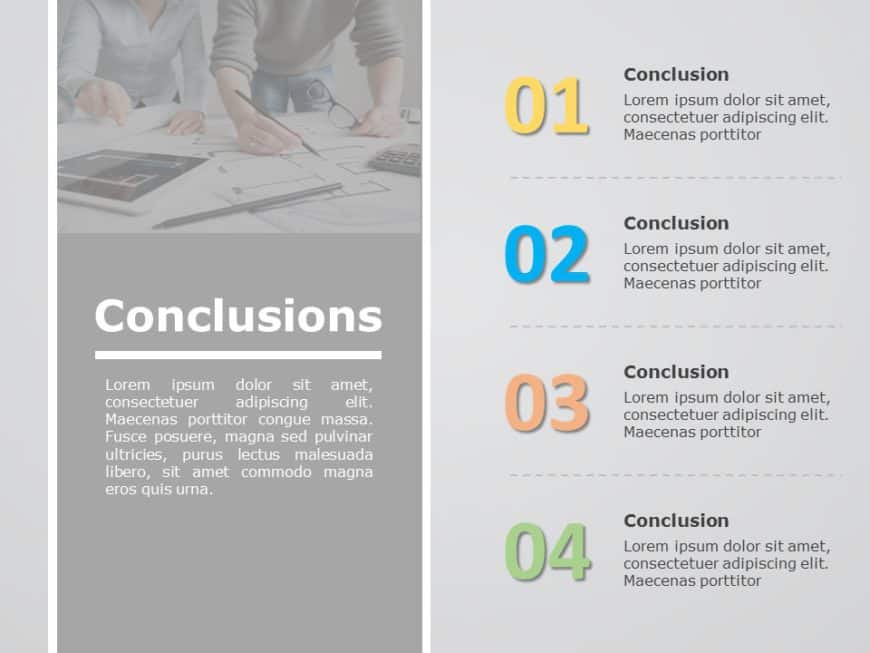
Conclusion Slide 13 PowerPoint Template
This template is a professionally designed template that helps you wrap up your presentation in style. This google slides template is perfect for....
- Conclusion Slide 16 - 4x3 – $4.99
- Conclusion Slide 16 - 16x9 – $4.99
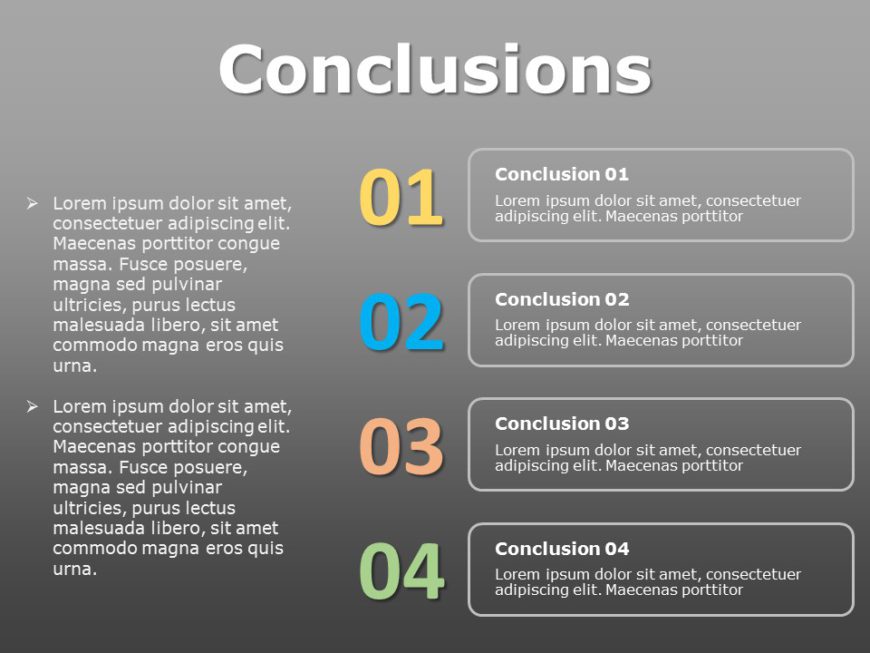
Conclusion Slide 16 PowerPoint Template
Conclusion Slide 16 Presentation Template Use this Conclusion Slide 16 PowerPoint template to create visually appealing presentations in any prof....
- Conclusion Slide 19 - 4x3 – $4.99
- Conclusion Slide 19 - 16x9 – $4.99
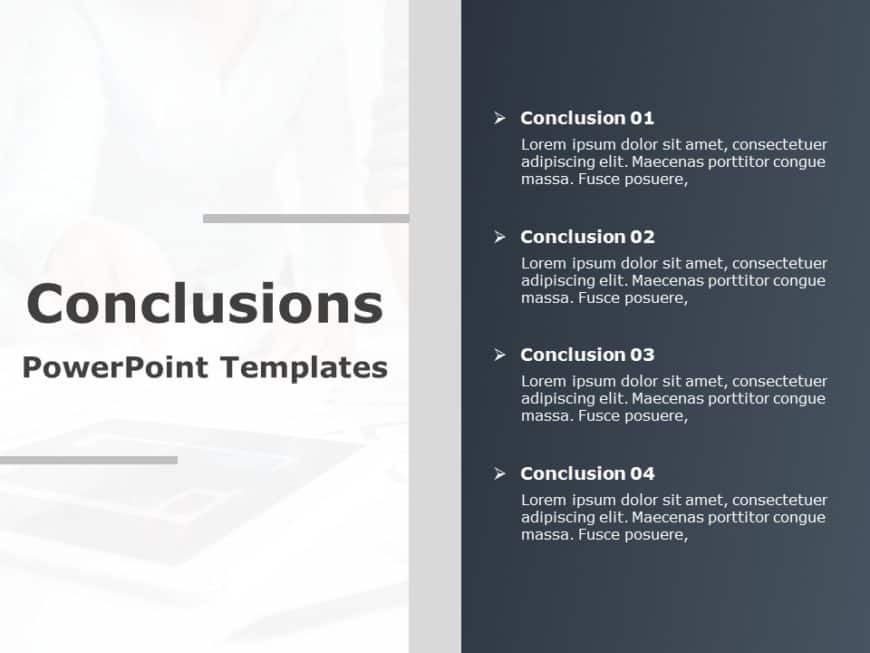
Conclusion Slide 19 PowerPoint Template
Conclusion Slide 19 Presentation Template Use this Conclusion Slide 19 PowerPoint template to create visually appealing presentations in any prof....
- Conclusion Slide 05 - 4x3 – $4.99
- Conclusion Slide 05 - 16x9 – $4.99

Conclusion Slide 05 PowerPoint Template
Conclusion Slide 05 Presentation Template Use this Conclusion Slide 05 PowerPoint template to create visually appealing presentations in any prof....
- Conclusion Slide With Question Prompt - 4x3 – $4.99
- Conclusion Slide With Question Prompt - 16x9 – $4.99
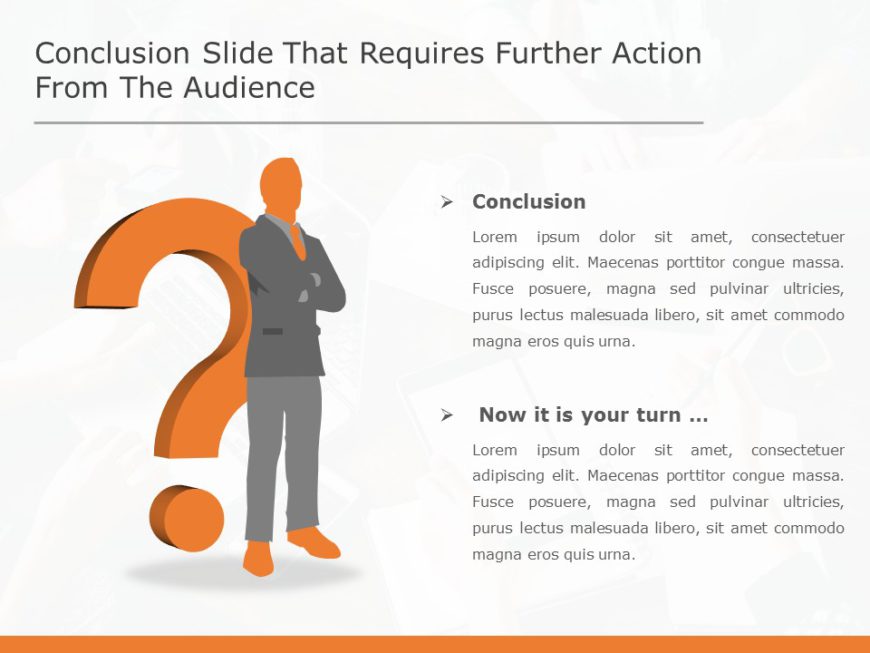
Conclusion Slide With Question Prompt PowerPoint Template
Conclusion Slide With Question Prompt Presentation Template Use this Conclusion Slide With Question Prompt PowerPoint template to create visually....
- Conclusion Slide 06 - 4x3 – $4.99
- Conclusion Slide 06 - 16x9 – $4.99

Conclusion Slide 06 PowerPoint Template
Conclusion Slide 06 Presentation Template Use this Conclusion Slide 06 PowerPoint template to create visually appealing presentations in any prof....
Related Presentations
Self introduction.
60 templates >
Slide Layout
4 templates >
45 templates >
Question Answer
23 templates >
Synopsis PowerPoint Templates for Presentations:
The Synopsis PowerPoint templates go beyond traditional static slides to make your professional presentations stand out. Given the sleek design and customized features, they can be used as PowerPoint as well as Google Slides templates . Inculcated with visually appealing unique and creative designs, the templates will double your presentation value in front of your audience. You can browse through a vast library of Synopsis Google Slides templates, PowerPoint themes and backgrounds to stand out in your next presentation.
Product Pricing
What is a synopsis powerpoint template.
A Synopsis PowerPoint template is a ready-made presentation template that provides a structured framework for creating professional Synopsis presentations. The Synopsis PPT presentation template includes design elements, layouts, and fonts that you can customize to fit your content and brand.
How To Choose The Best Synopsis Presentation Templates?
Keep the following points in mind while choosing a Synopsis Presentation template for PowerPoint (PPT) or Google Slides:
- Understand your presentation goals and objectives.
- Make sure the Synopsis template aligns with your visual needs and appeal.
- Ensure the template is versatile enough to adapt to various types of content.
- Ensure the template is easily customizable.
Are Synopsis PowerPoint Templates Compatible with Google Slides?
Yes, all our Synopsis presentation templates are compatible and can be used as Synopsis Google Slides templates.
What Are the Advantages of Synopsis Presentation Templates?
Synopsis PPT presentation templates can be beneficial because they:
- Add multiple visual and aesthetic layers to your slides.
- Ensure that complex information, insights and data is presented in a simplistic way.
- Enhance the overall visual appeal of the content.
- Save you a lot of time as you don’t have to start editing from scratch.
- Improve the professional outlook of your presentation.
Can I Edit The Elements In Synopsis PowerPoint Templates?
Yes, our Synopsis PowerPoint and Google Slides templates are fully editable. You can easily modify the individual elements including icons, fonts, colors, etc. while making your presentations using professional PowerPoint templates .
How to Download Synopsis PowerPoint Templates for presentations?
To download Synopsis presentation templates, you can follow these steps:
- Select the resolution (16*9 or 4*3).
- Select the format you want to download the Synopsis template in (Google Slides or PowerPoint).
- Make the payment (SlideUpLift has a collection of paid as well as free Synopsis PowerPoint templates).
- You can download the file or open it in Google Slides.
Forgot Password?
Privacy Overview
Necessary cookies are absolutely essential for the website to function properly. This category only includes cookies that ensures basic functionalities and security features of the website. These cookies do not store any personal information
Any cookies that may not be particularly necessary for the website to function and is used specifically to collect user personal data via ads, other embedded contents are termed as non-necessary cookies. It is mandatory to procure user consent prior to running these cookies on your website.

How to Create a Summary Slide in PowerPoint?
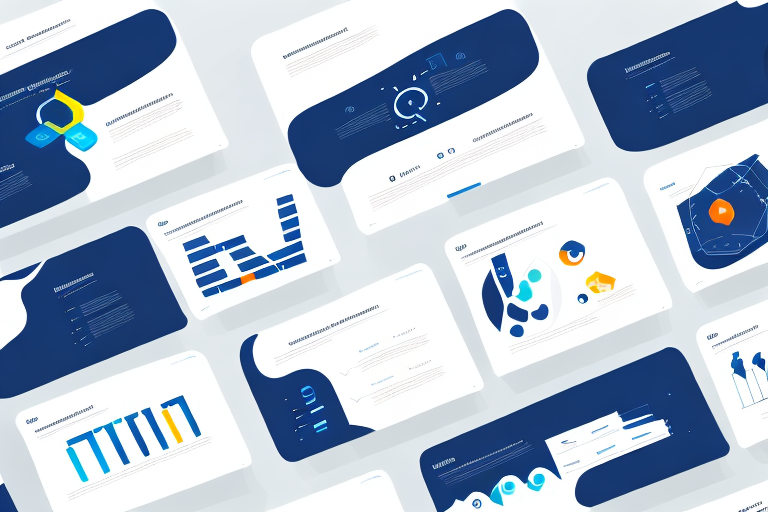
Creating a summary slide in PowerPoint is an essential part of putting together a presentation that grabs and holds your audience’s attention. Not only does it help to reinforce the key themes of your presentation, but it also serves as a powerful tool for summarizing complex information and data in an easy-to-understand format for your audience. In this article, we will explore the importance of a summary slide in PowerPoint presentations, how to plan and design an effective summary slide, and some best practices and tips for creating an engaging and informative summary slide.
Table of Contents
The Importance of a Summary Slide in PowerPoint Presentations
One of the key reasons why a summary slide is so important in PowerPoint presentations is its ability to reinforce the main themes and ideas of your presentation. By highlighting the most important points and takeaways, a summary slide can help to ensure that your audience remembers your presentation long after it is over. Additionally, a summary slide provides a clear and concise way to summarize complex data or information, helping to make your presentation more accessible and engaging for your audience.
Another benefit of including a summary slide in your PowerPoint presentation is that it can serve as a roadmap for your audience. By providing a clear overview of the topics covered in your presentation, a summary slide can help your audience to follow along and stay engaged throughout the entire presentation. This can be especially helpful for longer presentations or those that cover a lot of complex information.
Finally, a summary slide can also be a useful tool for reinforcing your call to action or key message. By summarizing the main points of your presentation and highlighting the key takeaways, you can help to ensure that your audience understands the importance of your message and is motivated to take action. This can be particularly important in business or marketing presentations, where the ultimate goal is to persuade your audience to take a specific action or make a purchase.
Understanding the Purpose of a Summary Slide in Your Presentation
Before you start creating your summary slide, it’s essential to understanding its purpose in your overall presentation. The summary slide is typically the last slide of your presentation, and it should summarize the most important points covered in your presentation along with a memorable final thought. For example, if you’re delivering a sales pitch, your summary slide should highlight the key benefits of your product or service and provide a clear call to action for your audience.
Another important aspect of a summary slide is that it helps your audience to remember the key takeaways from your presentation. By providing a concise summary of the main points, your audience is more likely to retain the information and be able to recall it later. Additionally, a well-crafted summary slide can also serve as a visual aid to reinforce your message and leave a lasting impression on your audience.
Planning Your Summary Slide: What to Include and What to Leave Out
When planning your summary slide, it’s important to strike the right balance between including enough information to summarize your presentation effectively while also avoiding overwhelming your audience with too much detail. Some key elements to consider including in your summary slide include the main themes and ideas covered in your presentation, key data points or statistics, any notable quotes or testimonials, and a final call to action. However, be sure to leave out any extraneous information that isn’t directly relevant to your main message or themes.
Another important factor to consider when planning your summary slide is the visual design. Your summary slide should be visually appealing and easy to read, with clear and concise text and graphics. Use a consistent color scheme and font throughout your presentation to create a cohesive and professional look. Additionally, consider using visual aids such as charts, graphs, or images to help illustrate your main points and make your summary slide more engaging for your audience.
Step-by-Step Guide to Creating a Summary Slide in PowerPoint
Creating a summary slide in PowerPoint is a straightforward process that can be accomplished using a few simple steps. First, choose the template or design for your summary slide. Most PowerPoint templates include a suitable summary slide layout, so you don’t need to start from scratch. Next, consider the key message and themes of your presentation and decide what information to include in your summary slide. Be sure to keep your text concise and focused, and use bullet points or other visual aids to help keep things clear and easy to understand. Finally, add any relevant images, charts, or graphs to your summary slide, and make sure to use fonts and colors that are consistent with your overall presentation design.
It’s important to note that the summary slide should be the last slide in your presentation. This slide should provide a quick overview of the key points and takeaways from your presentation. It’s also a good idea to include a call to action or next steps on this slide, so your audience knows what to do next. Remember, the summary slide is often the slide that your audience will remember the most, so make sure it’s clear, concise, and visually appealing.
Designing an Eye-Catching Summary Slide for Your Presentation
While the content of your summary slide is essential, the design also plays a crucial role in creating an engaging and memorable summary slide. To design an eye-catching summary slide, consider using bold colors and fonts, incorporating relevant images or graphics, and using animations or slide transitions to help emphasize key points. Remember to keep your design consistent with your overall presentation theme and style.
Another important aspect to consider when designing your summary slide is the placement of information. You want to make sure that the most important information is prominently displayed and easy to read. This can be achieved by using larger font sizes or bolding key words. Additionally, consider using bullet points or numbered lists to break up information and make it easier to digest.
Finally, don’t forget about the importance of white space. A cluttered summary slide can be overwhelming and difficult to read. Leave enough space between elements to create a clean and organized design. This will not only make your summary slide more visually appealing, but it will also make it easier for your audience to understand and remember the information presented.
Tips and Tricks for Creating an Effective Summary Slide in PowerPoint
When creating your summary slide, there are a few tips and tricks that can help you to ensure its effectiveness. First, consider using a strong headline or tagline that sums up the main message or takeaway from your presentation. Second, use bullets or numbers to break down complex information into manageable chunks, making it easier for your audience to understand. Finally, use visuals like images or charts to help illustrate your key points, making them more memorable and engaging for your audience.
Another important tip to keep in mind when creating a summary slide is to keep it simple and concise. Avoid cluttering the slide with too much information or unnecessary details. Stick to the most important points and use clear and concise language to convey your message effectively.
Additionally, it can be helpful to include a call to action on your summary slide. This could be a request for feedback, a call to visit your website or social media pages, or an invitation to continue the conversation after the presentation. Including a call to action can help to keep your audience engaged and interested in your message beyond the presentation itself.
How to Customize Your Summary Slide with Animations and Transitions
PowerPoint offers a wide range of options for customizing your summary slide with animations and transitions. Animations can be used to bring attention to key points or data, while transitions can help to create a seamless flow between slides. When using animations and transitions, be sure to use them sparingly and consistently throughout your entire presentation.
Best Practices for Using Images and Graphics on Your Summary Slide
Images and graphics can be powerful tools for enhancing the impact of your summary slide. When using images and graphics, be sure to choose visuals that are relevant to your presentation and that help to reinforce your main message or themes. Additionally, use high-quality images and graphics that are visually appealing and easy to understand for your audience.
Adding Charts and Graphs to Your Summary Slide: A Comprehensive Guide
If your presentation includes complex data or information, charts and graphs can be an effective way to present it in a clear and easy-to-understand format. When adding charts and graphs to your summary slide, consider using simple designs and labels that are easy to read and interpret. Additionally, be sure to only include the most important data points or information on your summary slide, leaving out any unnecessary information that could confuse your audience.
Creating a Memorable Conclusion with Your Summary Slide
The last slide of your presentation should leave a lasting impression on your audience. To create a memorable conclusion with your summary slide, consider including a final call to action or memorable quote that reinforces your presentation’s main message. Additionally, use images, graphics, or animations to help emphasize your main points and leave a lasting impression on your audience.
How to Use a Summary Slide to Engage Your Audience
A summary slide can also be an effective tool for engaging your audience throughout your presentation. By previewing your summary slide at the beginning of your presentation, your audience will have a clear understanding of what to expect and will be more engaged and attentive throughout the rest of your presentation. Additionally, use your summary slide to encourage audience participation by asking questions or soliciting feedback on your key messages.
Examples of Amazing Summary Slides: Inspiration for Your Next Presentation
Looking for some inspiration for your next summary slide? There are plenty of examples of amazing summary slides that you can draw inspiration from. Some great examples include TED Talks and other presentations from thought leaders in your industry. Take note of how they use visuals, text, and other design elements to create engaging and memorable summary slides.
Common Mistakes to Avoid When Creating a Summary Slide in PowerPoint
When creating your summary slide, there are a few common mistakes to avoid. These include including too much information or detail, using fonts or colors that are difficult to read, and failing to use visuals or other design elements effectively. Additionally, be sure to proofread your summary slide carefully to avoid any spelling or grammatical errors that could detract from your message.
Wrap Up: Final Thoughts on Creating a Perfect Summary Slide in PowerPoint
Creating an effective summary slide is a crucial part of any PowerPoint presentation. By following the tips and best practices outlined in this article, you can create a summary slide that not only reinforces the key themes and ideas of your presentation but also engages and informs your audience in a memorable and effective way.
By humans, for humans - Best rated articles:
Excel report templates: build better reports faster, top 9 power bi dashboard examples, excel waterfall charts: how to create one that doesn't suck, beyond ai - discover our handpicked bi resources.
Explore Zebra BI's expert-selected resources combining technology and insight for practical, in-depth BI strategies.

We’ve been experimenting with AI-generated content, and sometimes it gets carried away. Give us a feedback and help us learn and improve! 🤍
Note: This is an experimental AI-generated article. Your help is welcome. Share your feedback with us and help us improve.

- Current Students
- News & Press
- Exam Technique for In-Person Exams
- Revising for 24 Hour Take Home Exams
- Introduction to 24 Hour Take Home Exams
- Before the 24 Hour Take Home Exam
- Exam Technique for 24 Hour Take Home Exams
- Structuring a Literature Review
- Writing Coursework under Time Constraints
- Reflective Writing
- Writing a Synopsis
- Structuring a Science Report
- Presentations
- How the University works out your degree award
- Personal Extenuating Circumstances (PEC)
- Accessing your assignment feedback via Canvas
- Inspera Digital Exams
- Writing Introductions and Conclusions
- Paragraphing
- Reporting Verbs
- Signposting
- Proofreading
- Working with a Proofreader
- Writing Concisely
- The 1-Hour Writing Challenge
- Editing strategies
- Apostrophes
- Semi-colons
- Run-on sentences
- How to Improve your Grammar (native English)
- How to Improve your Grammar (non-native English)
- Independent Learning for Online Study
- Reflective Practice
- Academic Reading
- Strategic Reading Framework
- Note-taking Strategies
- Note-taking in Lectures
- Making Notes from Reading
- Using Evidence to Support your Argument
- Integrating Scholarship
- Managing Time and Motivation
- Dealing with Procrastination
- How to Paraphrase
- Quote or Paraphrase?
- How to Quote
- Referencing
- Artificial Intelligence and Academic Integrity
- Use and limitations of generative AI
- Acknowledging use of AI
- Numeracy, Maths & Statistics
- Library Search
- Search Techniques
- Keeping up to date
- Evaluating Information
- Managing Information
- Thinking Critically about AI
- Using Information generated by AI
- Digital Capabilities
- SensusAccess
- Develop Your Digital Skills
- Digital Tools to Help You Study

Learn how to prepare and write a synopsis assignment.
- Newcastle University
- Academic Skills Kit
- Assignment Types
A synopsis is a brief summary which gives readers an overview of the main points. In an academic context, this is usually a summary of a text (a journal article, book, report etc) but in some instances you might be writing a synopsis of a talk, film or other form of presentation. A synopsis is a neutral summary, objectively capturing the main points, rather than your own perspective or critique, and it focusses directly on the text you’re summarising rather than being a wider discussion of a topic, as an essay might be.
A synopsis aims to give the reader a full, if brief, account of the whole text so that they can follow its main points without having to read it themselves. It’s not a ‘trailer’ designed to tempt your audience to read the text itself, so you don’t have to worry about ‘hooking’ them in with hints and high points or ‘spoiling the ending’ - give the whole text equal coverage, including the conclusions. You could add some commentary which gives the reader a bit of context about the text, including the authors and circumstances it was written in (for example, if it is part of a debate, particular school of thought or its significance and what impact it’s had).
Writing a good synopsis is a skill, and there are a number of challenges:
- Separating the main points from the minor detail
- Knowing what to leave out as well as what to include
- Giving a sense of the overall narrative as well as listing the key points
- Covering the whole text within a small word limit
- Knowing how closely to stick to the original, especially in terms of the wording
- Whether to give all key points equal treatment, or cover some more briefly, even combining them
- Rephrasing things concisely without losing the meaning or misrepresenting it
- Not leaving out anything crucial to understanding the whole overall message
A good synopsis will allow the reader to feel as if they’d skimread the whole text themselves, understanding the overall gist and highlighting what they need to know. A poor synopsis will get bogged down in detail, giving a confused account of the whole story by just listing points, miss out major points or give an inaccurate or one-sided account or stick so closely to the original that it becomes plagiarism without demonstrating a real understanding by the person summarising it.
How to prepare a synopsis
Boiling down the key points and overall narrative of the original means good reading and note-taking skills which aim to identify and boil down key points to their essence. You could try some of the following approaches:
- Read the whole text, and afterwards, without re-reading, jot down your first initial summary in 50 words to capture its overall point. You can check it back for accuracy or anything you left out, but stick within ca 50 words
- Read the introduction and first line of each paragraph to get a sense of the overall structure and key points within it
- Highlight one sentence in each paragraph that you think is essential detail to understanding that section
- Alternatively, with a marker pen, cross out anything that isn’t essential to an understanding of the whole section or text
- Jot down only key words as a summary of each point rather than whole sentences
- Read each paragraph and summarise it without looking, in one sentence of your own
- Consider how many points you can make within your word count, and reduce or combine your list of summarised points down to this number
You could start small, identifying just keywords or sentences at first and then work them up into phrases, bullet points and sentences as a rough plan or draft, or you could start big with the original text and reduce each section, paragraph and sentence summary again and again until you have boiled it down to its essence.
When you start to prepare your first plan or draft, try to use your notes or memory and step away from the original as much as you can. You can go back and check it afterwards, but you need to create some distance to be able to create your own account and have confidence in the points you have identified as essential.
Writing a synopsis
The main decisions facing you as you write up your summary are about how closely to stick to the original in terms of structure and style, and how much attention to give to each point.
- You could begin your synopsis with a brief context, explaining who the authors are, the context and significance of their work, as well as anything you think might help the reader to understand the following summary
- The most common structure is to follow that of the original text, to give a sense of its narrative flow as well as the key points within it. You could choose to depart from it a little though, perhaps glossing over some points faster than others, combining two sections which go together or aren’t enough in their own right, possibly even changing the order a little where it helps to combine two similar points. Careful use of signposting language will help the reader clearly follow the structure (and note anywhere you’ve changed it from the original) so they can identify the bit you’re talking about in the original if they want to
- The style will naturally be strongly influenced by the original wording, but you should phrase it in your own words wherever possible. It’s harder to nibble away words from a much longer original than it is to start again and use your own concise phrasing, and you want to demonstrate your own understanding to the reader. You could use the odd original phrase or quotation here or there, but the synopsis needs to be more than a collage of quotations; it’s a thing in its own right rather than a cut-down version of the original
- You can also show your own response to the text in the way you use language to guide the reader to what you feel are the key points and (briefly) why. Your own voice doesn’t need to be very obvious in the synopsis, as it’s about the text rather than your reaction to it, but you have made analytical decisions about what is important, and might want to explain to the reader why these points are significant in understanding the whole
- What is the main purpose of this text? What did it aim to discover, explain or prove?
- Why was this research done? How significant is it?
- How was the research conducted? What kind of research is it?
- What were the three (or four, five) main things I should be aware of from this paper?
- What is their line of argument?
- What is their overall conclusion, recommendation, finding? Why is that important?
Managing word count
The trick to writing a concise synopsis which keeps within your word limit is not to start from the much bigger original text, but from your own boiled down notes. If you’re over the word count, you could start cutting out words that don’t seem essential, but if you go too far, you end up with a text which does not read well and doesn’t hang together. It might be better to remove whole sentences and perhaps whole points, than nibble away at words here and there.
Download this guide as a PDF
Learn how to prepare and write a synopsis assignment. **PDF Download**
Home Blog Business Executive Summary: A Guide to Writing and Presentation
Executive Summary: A Guide to Writing and Presentation
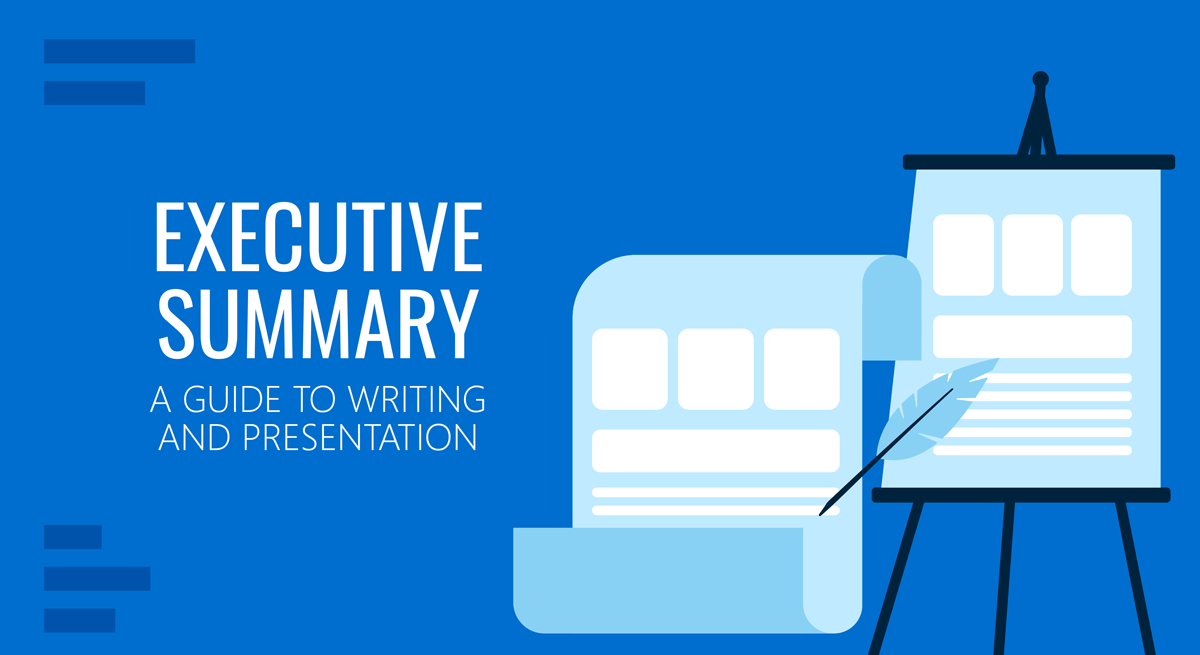
Executive summaries precede nearly every type of business document. Despite being the shortest part, they often leave the biggest impression on the reader. Yet, many writers choose to treat an executive summary as an afterthought. (And some presenters too!). Why? Because writing an executive summary is a seemingly hard task. But our mission is to prove otherwise!
What is an Executive Summary?
An executive summary is a preface to a larger business document such as an annual report, business plan, or whitepaper, succinctly summarizing the key discussion points. Effectively, an executive summary offers a preview of the content, so that the reader could form a baseline opinion about the contents prior to diving into a deep reading session.
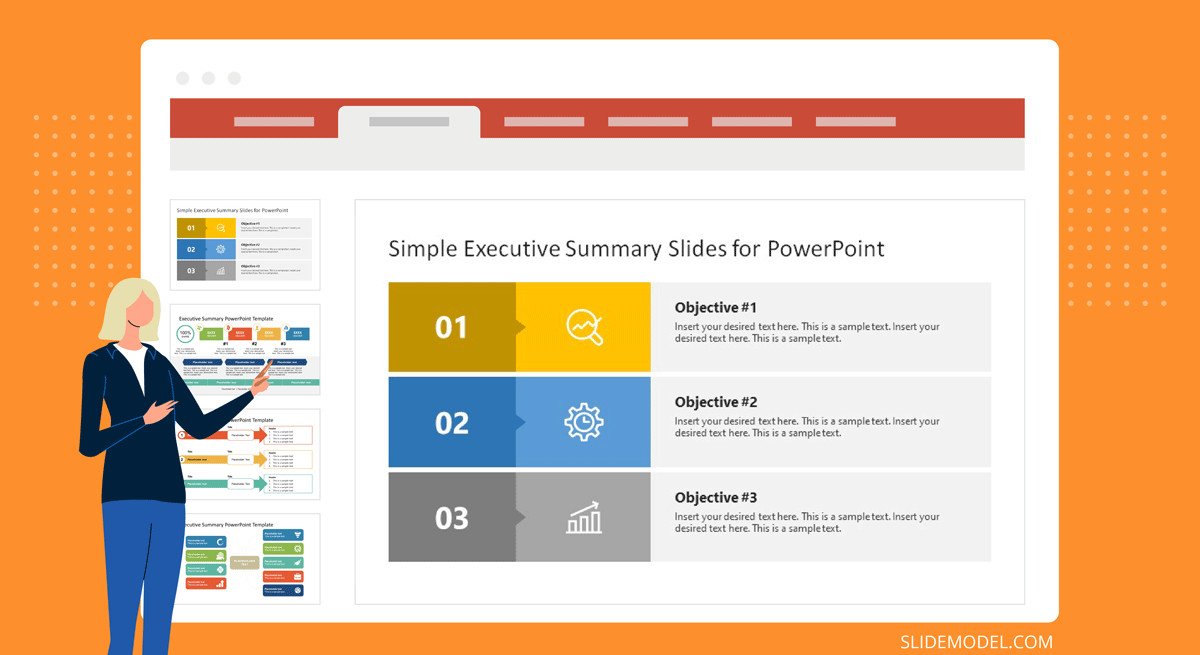
The University of Arizona offers a more elaborated executive summary definition which also notes that an executive summary should:
- Restate the purpose of the follow-up document
- Highlight the key discussion points and most notable facts
- Relay any notable results, conclusions, or recommendations
Though an executive summary is just a foreword to a bigger report, it’s one of the most labor-intensive items as you have to condense a lot of information into a high-level summary. Oftentimes, an executive summary also gets prominent placement in the follow-up presentation, done on the report.
Executive Summary Examples
Nearly every type of business document will have an executive summary. Some are better structured and presented than others. But it’s not just limited to business documents. Executive summaries are also used in scientific projects, articles, and education. Below are several admirable executive summary examples you may want to use as an inspiration for writing.
Accenture: Gaming: The Next Super Platform
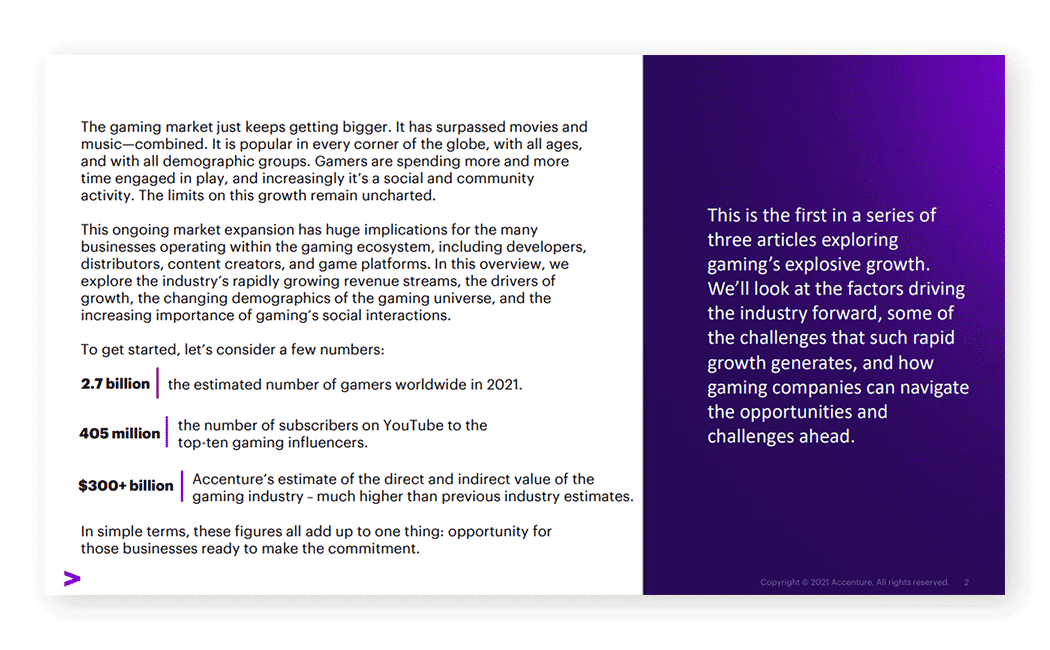
This executive summary for an industry report opens with some big quantifiable claims, clearly communicating the main agenda — describing the size and state of the global gaming market. The gaming industry is a huge market. The pullout texts on the sidebar further detail the scope of the document. Plus clarify for whom this report is intended.
IBM: Cost of a Data Breach Report 2020

IBM conducts an annual joint report on cybersecurity with Ponemon Institute. They open the executive summary with a brief recap of their mission and past research. Then dwell on this year’s findings and methodology. If you are writing an executive summary for a similarly massive original research, it’s worth focusing more on your techniques for obtaining data and arriving at the conclusions as IBM did.
Deloitte Digital: Exploring the value of emotion-driven engagement

Deloitte selected a more narrative style for this executive summary, mixing some key data points and methodology with the core messaging of the report. This is a good example of structured data presentation . On one hand, you have an engaging narration flow. On the other, the summary covers all the important discussion points.
Executive Summary Format
As the above executive summary examples illustrated, there is no one fit-it-all format for writing an executive study. The best approach depends on your report type, purpose, and contents.
That being said, an executive summary needs to fulfill several earlier mentioned criteria — offer a preview, provide key information at glance, showcase any results, recommendations. That’s what most readers expect to see on the first page after all.
The easiest way to approach writing is to draft a preliminary executive summary outline featuring the following subsections:
- General introduction, explaining the key problems discussed
- Main problem statement(s)
- Selected findings or recommendations
- The importance of discussed points
Since you’d also be likely working on presenting the executive summary to other stakeholders , it helps you keep the above structured as bullet points at first. So that you could easily transfer the main ideas to your executive summary PowerPoint slide .
How Long Should an Executive Summary Be?
As a rule of thumb, an executive summary should not go longer than one vertical page. That is an equivalent of 300-500 words, depending on the typeface. For longer reports, two pages (a horizontal split) may be acceptable. But remember, brevity is key. You are working on a trailer for a movie (the full report).
How to Write an Executive Summary: a 3-Step Framework
You can start with the aforementioned loose format and then adapt it to your document type. Remember, you don’t need to follow all the recommendations to a T. Instead, mix some ideas to make your executive summary sound both professional and engaging. Here are several tips for that:
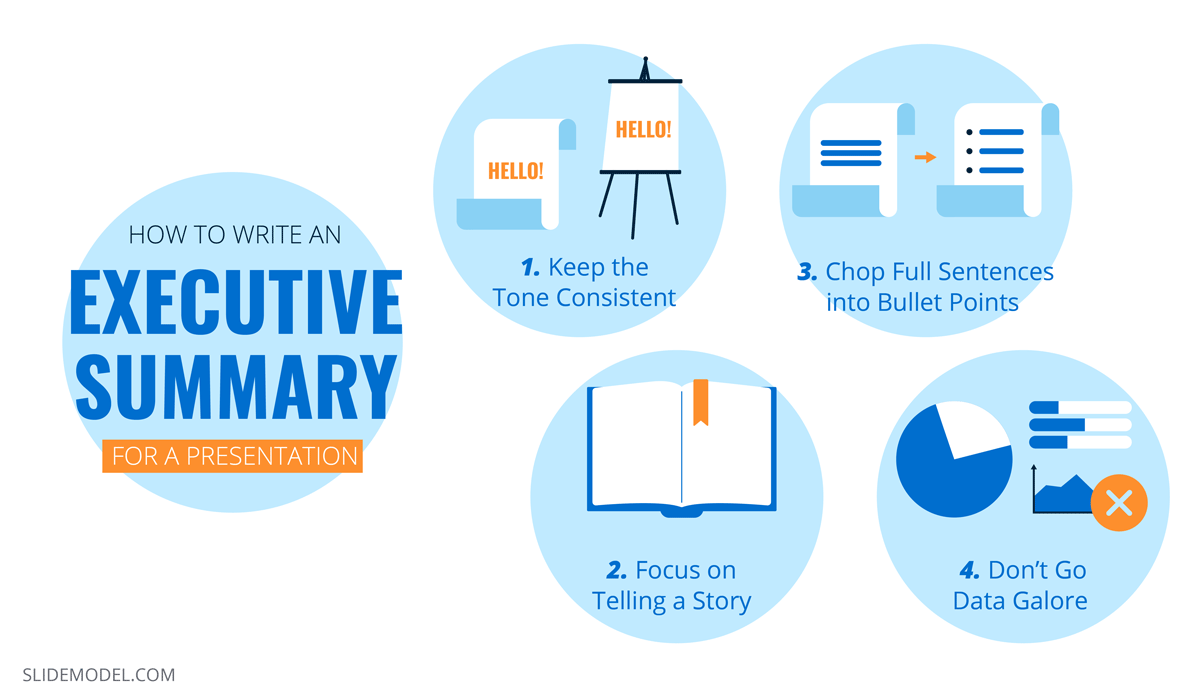
1. Start with a Problem Statement
Think of the first paragraph as if of an opening slide for a presentation : you need to make a big compelling statement that immediately communicates your agenda. Set the scene for the reader. There are several ways to do so:
- Answer the “why now” question in the opening paragraph
- Address the urgency of the matter
- Highlight the importance of the discussed issue
Alternatively, you can also go for a more traditional opening and explain the background of the research and discussed issue. For example, if you have conducted a go-to-market strategy evaluation for the team you can start by saying that “This report analyzed online furniture brand performance in 5 target EMEA markets in terms of market share, local brand recall, brand preference, and estimated online sales volumes.” Afterward, briefly communicate the main aim of the report.
2. Present the Main Discussion Points
Next, flesh out what’s included in the scope of this report to properly manage the reader’s expectations. You can use the report’s section subheads as key discussion points or come up with snappier, more descriptive statements.
Here are several good writing practices to follow:
- Use bullet points and numbered lists to break down text blocks.
- Quantify the biggest findings when possible. Style them as “call-outs”.
- Mention the limitations of your report and what it does not account for.
- Discuss the used research methods and data sources.
Finally, summarize the findings in one concluding paragraph if you have space. Or style it as a featured quote to draw the reader’s eye towards crucial information.
3. List the Recommendations or Next Steps
The bottom part of the page, around 100-150 words should be allocated towards underlining the results, conclusions, and follow-up action expected from the reader. Summarize what you have found during the course of your research. Mention if you have identified any specific type of solution or a type of recommended action.
Once you are done, send over an executive summary draft to a team member who hasn’t seen the complete report. Ask for their feedback. Can they tell what the report content is after reading the summary? Does the summary intrigue them? Is it descriptive enough for someone without any other context into the matter? Use the critique to further improve the document.

How to Prepare an Executive Summary Presentation
High chances are that you’ll also be asked to write the copy for the executive summary presentation, and perhaps even design it too. So let’s get you up to speed on this aspect as well.
How Does an Executive Summary Slide Look Like in PPT?
There’s no ultimate look for an executive summary slide as most presenters customize it to best reflect the content they’d want to showcase. But if you want some universal example, here’s our executive summary slide template :
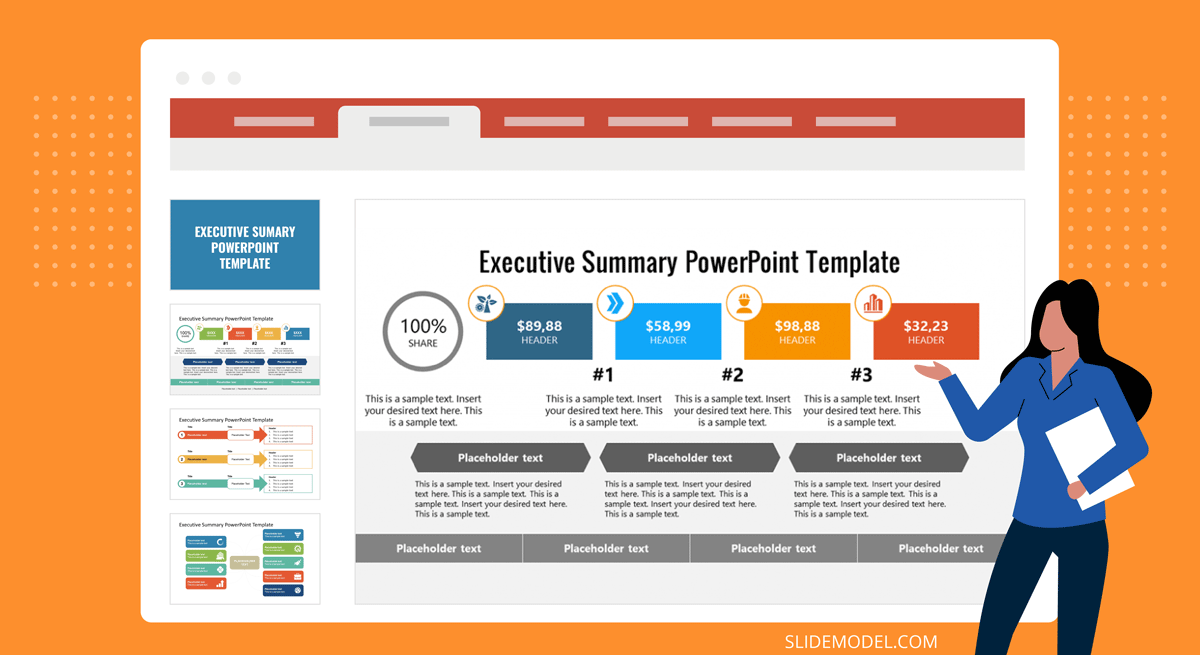
You can build an entire slide deck tailored for an executive summary or business presentation by using our AI Presentation Maker . Fill the topic, analyze & edit the proposed outline, and select a design. That’s it! You can create an engaging executive summary slide deck with any number of slides.
What Makes a Good Executive Summary Slide?
A good executive summary slide visually communicates all the important information from the full report. Typically, it’s an even more condensed version of the written executive summary, prefacing the document. Thus to create a good executive summary slide, be prepared to do some ruthless editing.
Include a condensed version of the:
- Main problem statement or report agenda
- Key findings. Prioritize quantifiable ones
- Recommendations and next steps.
Also, you will need some PowerPoint design mastery to ensure that an executive summary in your PowerPoint presentation looks compelling, but not cluttered. Prioritize white space. Here is where a good executive summary template can make your life easier. To minimize the number of texts, add icons and other simple visualizations. Trim headers and subheads to give the slide even more breathing room.
For those looking to create an engaging and visually appealing presentation, consider utilizing professional presentation templates to enhance the visuals of your executive summary slide. These templates are specifically designed to help presenters convey their message effectively and with style, ensuring that your audience remains captivated and fully understands the key points of your report.
How to Write an Executive Summary for a Presentation
Most likely you won’t need to write a brand new copy for this slide, but rather adapt the text at hand. That already makes your job a lot easier when summarizing a presentation into an executive summary slide. Still, you don’t want to mess anything up. So stick with the executive summary template you’ve chosen and fill in the gaps using our tips.
1. Keep the Tone Consistent
Use the same tone of voice and word choices in your slide deck as you’ve adopted in the report. If the tone of your presentation speech differs too much with terms used on the slide and in the report copy, some audience members may get confused, and then disengaged.
2. Focus on Telling a Story
Stakeholders will have the extra time to read the “dry” report. During the presentation, your main goal is to draw their attention to the most important issue, showcase the value-packed inside the report, and make them eager to learn more by actually flipping the full copy afterward.
3. Chop Full Sentences into Bullet Points
Go snappy and present information in a snackable manner. Remember, our brain can only keep 3-5 items at once in the working memory. So you shouldn’t try to overload the audience with a long list of “very important points” in one sitting.
Also, per a recent presentation survey, among the 3 things that annoy audiences most about presentations are slides that include full sentences of text. So, when working on your presentation summary slide, trim those lengthy texts and move on some of the other points to separate slides.
4. Don’t Go Data Galore
Including numbers and data visualizations is a great way to present your executive summary. However, overloading your data slides with data nuggets makes your presentation less impactful.
As presentation design expert Nancy Duarte explains :
“Data slides aren’t really about the data. They’re about the meaning of the data. It’s up to you to make that meaning clear before you click away. Otherwise, the audience won’t process — let alone buy — your argument.”
It’s a good idea to spotlight 3 main data points on your executive summary slide. Then use some extra minutes to comment on why you’ve chosen to present these.
To Conclude
An executive summary is the first page and/or slide a reader will see. That’s why the stakes are high to make it look just right. Granted, that shouldn’t be an issue. Since you now know how to write, design, and present a compelling executive summary to others!
1. Project Summary PowerPoint Template
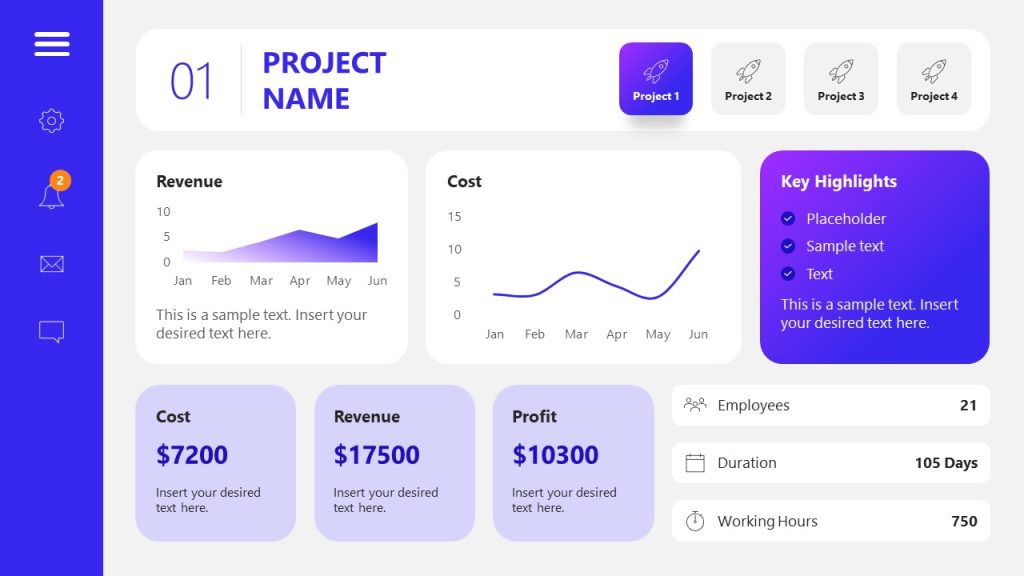
Use This Template
2. Simple Executive Summary Slide Template for PowerPoint
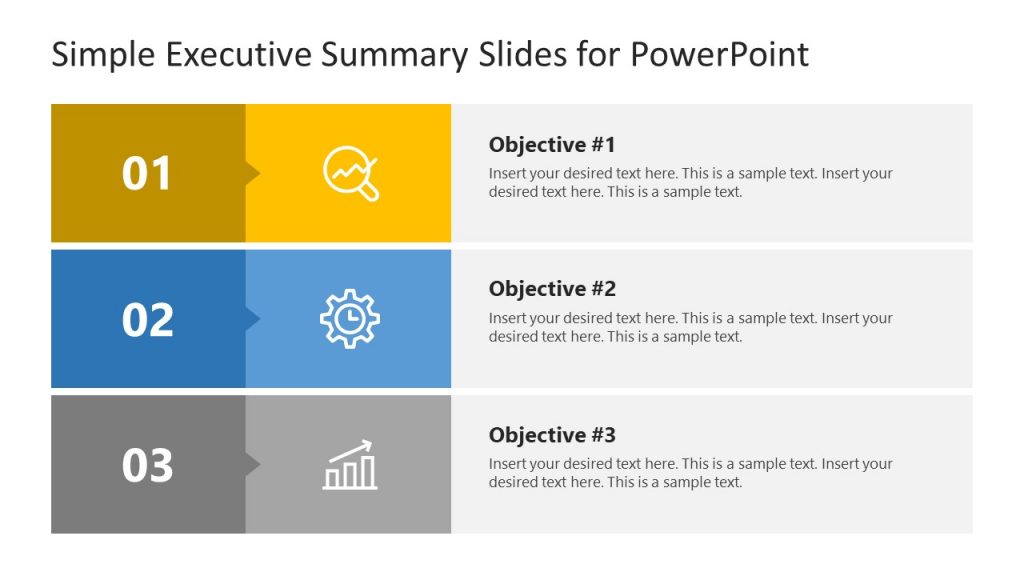
3. One Page Strategy Summary PowerPoint Template
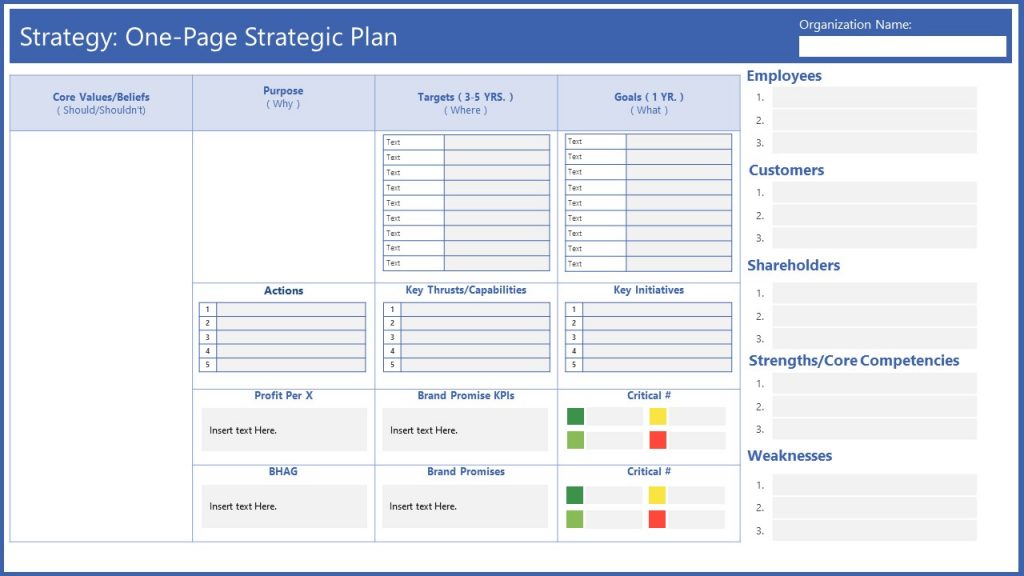
4. Executive Summary PowerPoint Template
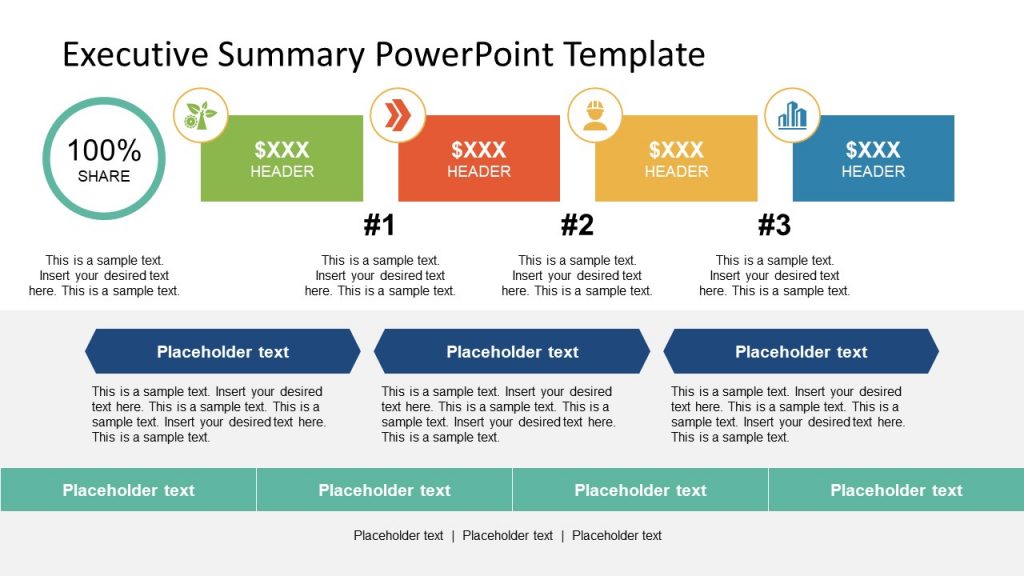
5. Executive Business PowerPoint Template

Like this article? Please share
Executive Reports, Executive Summary Filed under Business
Related Articles
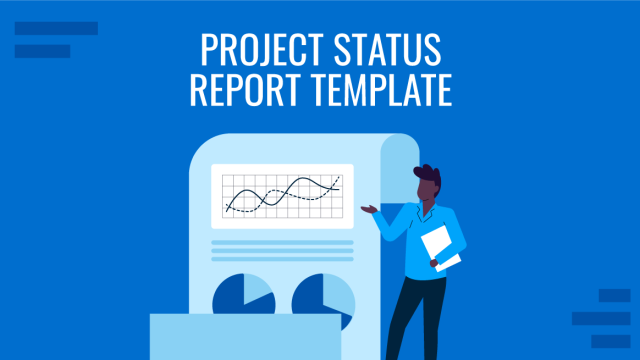
Filed under Business • August 31st, 2023
How to Build a Project Status Report Template: Complete Guide
Project status reports provide timely insights into project progress. Here are practical tips and a one-pager template for concise updates.

Filed under Business • October 25th, 2022
Business Presentation: The Ultimate Guide to Making Powerful Presentations (+ Examples)
A business presentation is a purpose-led summary of key information about your company’s plans, products, or practices, designed for either internal or external audiences. This guide teaches you how to design and deliver excellent business presentations. Plus, breaks down some best practices from business presentation examples by popular companies.
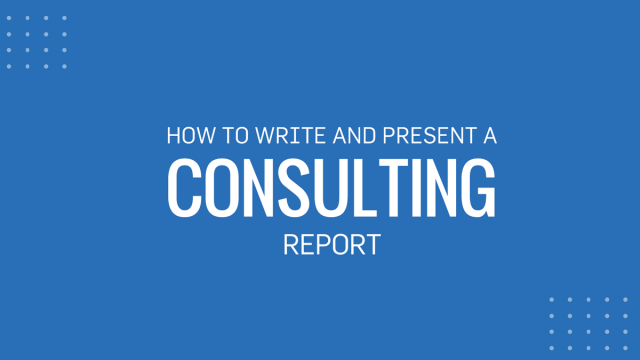
Filed under Business • October 7th, 2022
Consulting Report: How to Write and Present One
Consultants have many tools of the trade at their disposal: Frameworks, analytics dashboards, data science models, and more. Yet many clients still expect to receive a narrated consulting report. So how do you write one? This guide will show you.
Leave a Reply
Got any suggestions?
We want to hear from you! Send us a message and help improve Slidesgo
Top searches
Trending searches

8 templates

memorial day
12 templates

ocean theme
44 templates

environmental science
36 templates

art portfolio
82 templates

49 templates
Project Summary
It seems that you like this template, project summary presentation, premium google slides theme and powerpoint template.
Is your company embarking on their biggest journey ever? Perhaps the most ambitious project in their history? We're sure it will be very difficult to be aware of all the details, including the smaller ones. What you really need now is a summary! To start working on it right away, you just need the help of this editable template. It's great for creating presentations, and this one will remind you of a notebook, kind of. It has markers on the right side, to which you could add hyperlinks if you wish to jump to a certain part of the slideshow.
Features of this template
- 100% editable and easy to modify
- 35 different slides to impress your audience
- Contains easy-to-edit graphics such as graphs, maps, tables, timelines and mockups
- Includes 500+ icons and Flaticon’s extension for customizing your slides
- Designed to be used in Google Slides and Microsoft PowerPoint
- 16:9 widescreen format suitable for all types of screens
- Includes information about fonts, colors, and credits of the resources used
What are the benefits of having a Premium account?
What Premium plans do you have?
What can I do to have unlimited downloads?
Don’t want to attribute Slidesgo?
Gain access to over 24800 templates & presentations with premium from 1.67€/month.
Are you already Premium? Log in
Related posts on our blog

How to Add, Duplicate, Move, Delete or Hide Slides in Google Slides

How to Change Layouts in PowerPoint

How to Change the Slide Size in Google Slides
Related presentations.

Premium template
Unlock this template and gain unlimited access
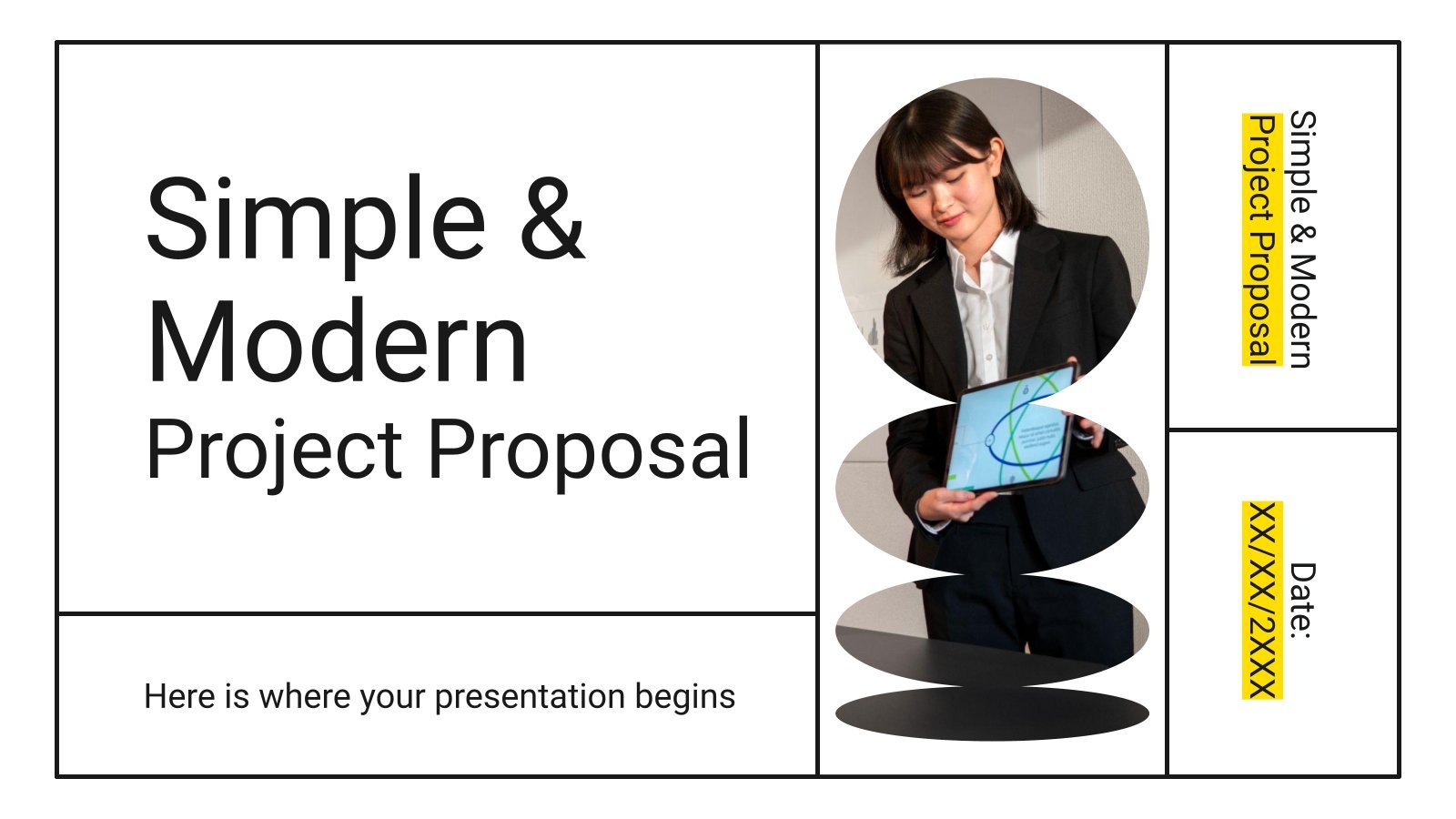
Register for free and start editing online
How To Write A Synopsis
How to Write a Synopsis – A Simple Format & Guide
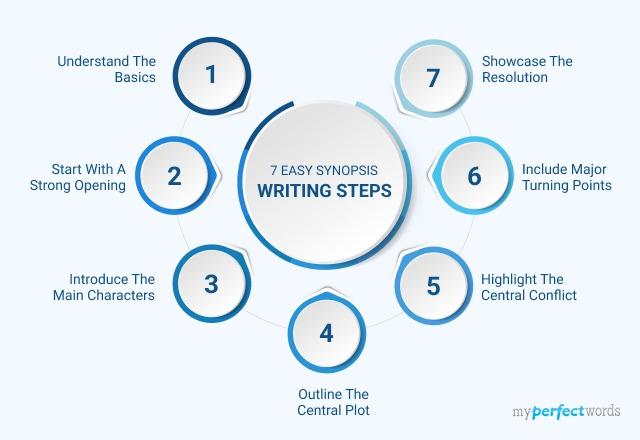
People also read
Learn How to Write an Editorial on Any Topic
Best Tips on How to Avoid Plagiarism
How to Write a Movie Review - Guide & Examples
A Complete Guide on How to Write a Summary for Students
Write Opinion Essay Like a Pro: A Detailed Guide
Evaluation Essay - Definition, Examples, and Writing Tips
How to Write a Thematic Statement - Tips & Examples
How to Write a Bio - Quick Tips, Structure & Examples
How to Write a Comparative Essay – A Complete Guide
Visual Analysis Essay - A Writing Guide with Format & Sample
List of Common Social Issues Around the World
Writing Character Analysis - Outline, Steps, and Examples
11 Common Types of Plagiarism Explained Through Examples
Article Review Writing: A Complete Step-by-Step Guide with Examples
A Detailed Guide on How to Write a Poem Step by Step
Detailed Guide on Appendix Writing: With Tips and Examples
Are you finding it tough to summarize your detailed story into a short synopsis? If the thought of summarizing your narrative seems overwhelming, know that many students face this challenge.
Imagine the frustration when you have worked hard to create an interesting story, only to feel stuck when trying to make a short synopsis.
But don't worry!
In this blog, we'll not only explain how to write a synopsis but also highlight common mistakes that students make.
Let's begin!

Paper Due? Why Suffer? That's our Job!
- 1. What is a Synopsis?
- 2. How to Write a Synopsis?
- 3. How to Format a Synopsis?
- 4. How To Write A Synopsis Examples
- 5. Tips for Writing the Perfect Synopsis
What is a Synopsis?
A synopsis is a concise and systematic summary of a larger piece of work, typically a book, movie, play, or academic paper.
In literature, a book synopsis is a short summary that talks about the main parts of a story, like main characters, and central conflict.
For movies, a synopsis is a brief summary that tells the main story, introduces the characters, and sometimes gives away exciting parts of the plot.
In academia, a research paper synopsis is a short description that talks about what the study is trying to do, how it's done, what was found, and what it all means.Pu
Purpose of Writing a Synopsis
The purpose of writing a synopsis is to provide a concise and informative overview of a larger work, be it a book, movie, or research paper.
In simpler terms, when creating a synopsis, it's important to focus on a few key things:
- Making sure the information is easy to understand
- Getting people interested, helping in decision-making
- Presenting it professionally
- Meeting specific submission guidelines.
Think of a synopsis as a helpful tool that tells a little bit about the big work and follows the rules for where it's being sent.

How to Write a Synopsis?
Writing a synopsis is not a difficult task if you follow the correct procedure. A good synopsis requires proper planning and preparation.
The following are the steps involved in writing synopses effectively:
Understand the Basics
Before starting your synopsis, thoroughly understand the work you're summarizing.
Identify the main characters, character motivations, the central conflict, and the key themes. This foundational understanding is crucial for creating an accurate and engaging summary.
Start with a Strong Opening
The opening of your synopsis should grab attention and set the tone for the story. It should introduce the main elements without giving away too much.
Introduce the Main Characters
Briefly introduce the main characters, emphasizing their roles and relationships within the story. Focus on the key traits that drive their actions.
Outline the Central Plot
Summarize the main plot, emphasizing the key events that drive the story forward. Include the central goal or conflict that propels the characters.
Highlight the Central Conflict
Identify and emphasize the central conflict or challenges the characters face. Clearly articulate the obstacles that stand in their way.
Include Major Turning Points
Highlight significant turning points or major plot twists that add complexity and intrigue to the story. These moments should showcase the characters' development and contribute to the overall narrative.
Showcase the Resolution
Provide a glimpse of how the story concludes without giving away all the details. Indicate how the central conflict is resolved and what changes for the characters.
Tough Essay Due? Hire Tough Writers!
How to Format a Synopsis?
Formatting is a crucial aspect of creating a professional and visually appealing synopsis for agents and editors. Here are some formatting guidelines to consider:
- Keep your synopsis concise, typically around 500 to 700 words. Focus on key plot points and essential details without unnecessary elaboration.
Font and Size:
- Use a standard, easily readable font such as Times New Roman or Arial.
- Use a font size between 10 and 12 points for optimal readability.
Margins and Spacing:
- Set standard one-inch margins on all sides of the document.
- Use standard single-space or double-spacing to enhance readability.
- Use clear and straightforward language. Avoid overly complex sentences or excessive details. Aim for a style that reflects the tone of your work.
Presentation:
- Format your synopsis with a readable font and standard font size. Use a professional layout with clear headings and sections to enhance readability
Character Names:
- Introduce characters by their full names in bold and capslock when first mentioned. This helps clarity without repeating full names.
Character Thumbnails:
- Include brief character thumbnails, providing key traits or motivations. This helps the reader quickly understand the characters' roles in the story.
Extra Points:
- Focus on major plot points and avoid including every detail. Be selective and emphasize on the most impactful elements.
Paragraph Structure:
- Organize your synopsis into clear paragraphs for each section, such as the introduction, main body, and conclusion.
Third Person Presentation:
- Write the synopsis in the third person, even if your story is primarily in the first person. This maintains a professional and objective tone.
- Write your synopsis in the present tense, regardless of the tense used in your actual work. This creates immediacy and engagement.
Document Type:
- Save your synopsis in a widely accepted document format, such as .doc or .pdf.
File Naming:
- Provide a clear and concise file name that includes the title of your work. For example: "Title_Synopsis.docx"
By adhering to these formatting guidelines, you can present a polished and professional synopsis that showcases your attention to detail.
How To Write A Synopsis Examples
Writing a synopsis means summarizing a big piece of work in a short and interesting way. It could be a story, a movie, or even a research paper.
Let's look at some important ideas and examples to help you get better at writing a good synopsis.
How To Write A Synopsis Sample:
How to Write a Synopsis for a Film
TV Show Synopsis - Example
Synopsis Example for Novel
Synopsis For a Book
Synopsis For a Short Story
Synopsis For a Story
Synopsis For a Short Film
Here are some more examples related to synopsis writing for research and academia!
Thesis Synopsis - Example
Synopsis For Research
Synopsis For a Project
A Synopsis For Phd
Synopsis of an Article
Tips for Writing the Perfect Synopsis
Here are some essential tips to help you refine your synopsis-writing process and create a compelling summary that captivates your audience:
- Focus on the Main Plot: Avoid including every detail; instead, highlight the key events that drive the story forward.
- Capture the Tone of the Work: Reflect the mood and style of the original work in your synopsis.
- Emphasize Conflict and Stakes : Clearly articulate the central conflict and what's at stake for the characters.
- Avoid Spoilers: Provide enough information to generate interest without giving away critical plot twists or the ending.
- Keep It Concise: A synopsis is a snapshot, not the entire story. Aim for clarity and conciseness to maintain the reader.
All in all, now you have a detailed guide on how to write a synopsis. Take help from the tips and examples to craft an engaging synopsis on your own!
But if you are still confused or don’t have time to complete your synopsis, MyPerfectWords.com is always just a click away!
Our essay writing service for college offers high-quality services. We have experienced essay writers who can easily write your synopsis without any errors.
They understand your requirements and tailor them according to your needs.
So, why wait? Hire a paper writer now and get your synopsis on time!
Frequently Asked Question
What is the difference between a synopsis and a blurb.
The synopsis is comprehensive and aimed at agents, publishers, or those seeking a detailed understanding. While the blurb is concise and crafted for readers to decide if they want to engage with the book.
How Do You Start Writing A Synopsis?
To start writing a synopsis, begin by identifying the main elements of your work, including the central plot, key characters, and major themes.

Write Essay Within 60 Seconds!

Dr. Barbara is a highly experienced writer and author who holds a Ph.D. degree in public health from an Ivy League school. She has worked in the medical field for many years, conducting extensive research on various health topics. Her writing has been featured in several top-tier publications.

Paper Due? Why Suffer? That’s our Job!
Keep reading


Synopsis Presentation Template
Download this template as well as our other 21,747 templates for only $99.

Slide: 1 / 20
Synopsis Presentation Template Special Features
Make your next PowerPoint, Google Slides, or Keynote presentation more effective with our professionally designed Synopsis template. Improve the way you present seminars, webinars and lectures. Make more exciting sales presentations, trade show displays and product promotions, or use them in any educational setting for more impact and greater retention.
Synopsis presentation template includes built-in layouts and stunning backgrounds to make your presentation a winner. The attention we pay to the finest detail make this presentation template truly world-class.
We take pride in employing features most companies skip because it's "too much work." This Synopsis presentation theme is carefully considered and implemented to maximize the beauty, consistency, clarity and -- most importantly -- audience impact of your presentation.
Intuitive and Easy To Use
Enhanced colors, stunning imagery, professional typography, make life easy, 17 professional pre-made slides, make life even easier.
All our presentation templates are saved in POT, PPT, and PPTX formats to make them compatible with your presentation software like Office for Mac, Keynote, Google Docs, OpenOffice, and others. Some MS PowerPoint features may not be supported by your presentation software. Please read more about Microsoft PowerPoint compatibility in your software documentation.
- All Themes (16676)
- Abstract/Textures (2449)
- Agriculture (338)
- America (206)
- Animals and Pets (344)
- Animated (32)
- Art & Entertainment (802)
- Business (1951)
- Business Concepts (3754)
- Careers/Industry (2977)
- Cars and Transportation (482)
- Computers (284)
- Construction (976)
- Consulting (2852)
- Education & Training (2803)
- Financial/Accounting (903)
- Flags/International (297)
- Food & Beverage (754)
- General (12382)
- Global (704)
- Health and Recreation (306)
- Holiday/Special Occasion (1167)
- Legal (219)
- Medical (1236)
- Military (137)
- Nature & Environment (1665)
- People (1868)
- Politics and Government (234)
- Real Estate (283)
- Religious/Spiritual (480)
- Sports (732)
- Technology and Science (2159)
- Telecommunication (497)
- Utilities/Industrial (407)
With the all-inclusive price of $99 you are only paying $.01 per template!
Join our 81,532 happy customers and get complete access to our 21,747 templates, 100% satisfaction guaranteed or your money back.
sign up today

Researched by Consultants from Top-Tier Management Companies

Powerpoint Templates
Icon Bundle
Kpi Dashboard
Professional
Business Plans
Swot Analysis
Gantt Chart
Business Proposal
Marketing Plan
Project Management
Business Case
Business Model
Cyber Security
Business PPT
Digital Marketing
Digital Transformation
Human Resources
Product Management
Artificial Intelligence
Company Profile
Acknowledgement PPT
PPT Presentation
Reports Brochures
One Page Pitch
Interview PPT
All Categories
Top 10 Project Summary Templates with Samples and Examples
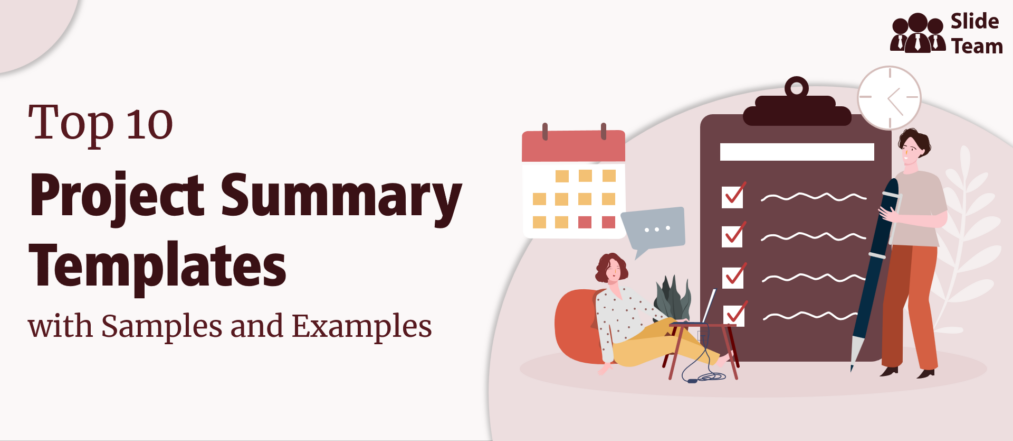
Sapna Singh
“A specification, design, procedure, or test plan that will not fit on one page cannot be understood,” this anecdotal piece of wisdom always hits home for businesses that want to improve their project management success rate. Ultimately, project success feeds into organizations achieving their mission and vision. The above quote also is a golden rule for over half of the project managers, who create a scope document for their initiatives.
A condensed version (project summary) of a whole project on a single page is compelling communication. It is also a brilliant, hands-on project management tool for providing critical information to stakeholders, clients, and employees.
Explore our library of templates that will take your project reports to the next level with their outstanding quality and inventive style. Click here to learn more about Project Report Summary Templates .
Project Summary: A project management tool to get a synopsis of project status at a given time
A project summary provides a summary of the proposed project, including crucial details. This information is your finest chance to pique everyone’s interest and persuade them of the necessity and quality of your project. Project summaries condense the project's objectives, requirements, challenges, analysis, and conclusion, turning it into an indispensable resource in the beginning stages of any project plan.
Get the most popular Project Executive Summary Templates to demonstrate business concepts and their effects on your company's structure.
This blog delves deeper into the specifics of producing project summaries, from goals and structure to examples. It provides a comprehensive overview of Project Summary Templates to summarize why and how the project was carried out and the results and consequences.
Use SlideTeam’s PPT Templates to record critical information about any project. These templates are a vital resource for project managers to simplify reporting and responsibility, while reducing the complexity of information into formats that are easy to grasp.
The 100% customizable nature of the templates provides you with the flexibility to edit your presentations. The content-ready slides give you the much-needed structure.
Use SlideTeam’s top-notch PowerPoint Templates to give readers a quick overview of the project's nature, status, and broader context!
Template 1: project brief summary ppt.
A project brief helps communicate project specifics to stakeholders. Use this PPT Template to show a project overview of key project elements. This comprehensive deck allows you to convey project objectives, budgets, strategies, and schedules to stakeholders. This template is an excellent tool for project managers to unite everyone to achieve a single goal. Use this presentation to collect information for your project and make it available to all stakeholders. Get it now!

Download this template
Template 2: Project Summary PPT
Use this PPT Template as a standalone document to present a general project overview, brief, and essential project deliverables. This comprehensive deck samples and project summary report templates for varied scenarios. Use this download to customize the major components of each project summary to your specific requirements and enhance your project management game. Download now!

Template 3: Project Status Report with Executive Summary
A project status report is required to calculate the project schedule. Use this PPT Template to present a high-level overview of a project's progress tracker and accomplishments. It includes the project phase, current status, milestones, budget, and issues. This template will assist you in making sure everything is proceeding as planned and that there are no obstacles. Using the pre-formatted tables, use this presentation to build a detailed report by organizing data into a clear project summary. Save this template now!

Template 4: Executive Summary of a Project Report
Use this PPT Template to present a quick project overview of your company plan. This template serves as a project brief containing elements such as a firm description, financial information, and market analysis to clarify for strategic partners, team leadership, and project stakeholders. This presentation helps clarify things for lenders, investors, and employees who don’t have time to read the proposal. Use this presentation to comprehend concepts and make sound judgments. Download now!

Template 5: Executive Summary of a Technical Project Report
Here’s another executive summary format for a technical project overview. Use this PPT Template to emphasize primary objectives, project budget, and schedule. It will assist you in restating the report's aim, highlighting key aspects, and describing any results or conclusions. Use this presentation to quickly obtain crucial information to decide on a plan of action. Get it now!

Template 6: Project Charter Management One-Page Summary Report
Use this PPT Template to create a project charter that will serve as a road map for the team. This project is an essential aspect of project management that can be referred to throughout the project’s lifecycle. This presentation provides project objectives, scope, and responsibilities to help you win approval from key project stakeholders. Use this download to demonstrate the viability of your idea and the potential return on investment. Get it now!

Template 7: Monthly Project Summary One-Pager Report
Use this PPT Template to present an overview of the project's progress. This overview comprises a project summary, stages, key challenges, and a monthly action plan. This will enable you to describe how a specific project is progressing to determine its project completion date. Use this presentation to provide a clear and concise review of the month's events and significant findings. Get it now!

Template 8: Multiple Project Issue Tracker Summary
Use this PPT Template to plan and track your organization’s project tasks. This template explains the project issue overview to assist you in managing tasks and resources required to complete many projects on schedule, all in a single, simple manner. It comprises details about the issue, the department, the reporting date, the critical person, the current status, and the priority. Use this presentation to standardize your project tracking process and ensure the project teams have updated information. Grab this slide now!

Template 9: Project Summary Accomplishment with Planned Timeline
Project timelines are the ideal tool for providing a quick, visual summary of a project from beginning to end. Use this PPT Template to present an in-depth project overview to your team to boost work efficiency. It includes a project summary, project deliverables, and significant risks and issues to help identify any gaps or overlaps in the project’s scheduled activities. Use this presentation to track significant progress on a project or product. Get it now!

Template 10: Start-Up Project Management Summary Report with Budget and Risk
Use this PowerPoint Presentation to present a high-level overview of a start-up project’s current condition. It displays the general status, project schedule, risks, issues, and pending actions to inform employees and stakeholders of the project's progress and any critical obstacles. Use this slide to boost visibility and clearly show how your project is progressing. Get it now!

Set up your project details in advance
Discover the precise, tried-and-true system for engaging stakeholders, improving cooperation, and launching projects with an overview of the scope of the chosen project. Use SlideTeam's PPT Templates to help you create a clear, concise, and engaging project summary so that everyone participating is aware of the whole strategy.
PS Check out our content-ready and customized One-Page Project Summary PowerPoint Templates to stay current on the project's status without needing in-depth explanations or further discussions.
FAQs ON PROJECT SUMMARY
What is the ideal length for a project summary.
There is no hard and fast rule about the length of your project summary. The basic thumb-rule is to keep it as brief as feasible. The readers have limited time and want to get to the point quickly. The possibilities range from a few phrases to several pages, depending on the project's complexity and the target audience's needs. However, summaries should be kept brief to capture readers' attention and effectively provide crucial information.
What is a project summary on one page?
A one-page project summary concisely describes a project that includes key features such as objectives, deliverables, timelines, and key stakeholders. It gives a high-level overview of the project's objective, scope, and expected outcomes.
What to include in a project summary?
- Introduction to your project and essential project information.
- An overview of your project's aims, objectives, and rewards.
- A summary of potential project obstacles, dangers, and challenges that may develop during the project's lifespan.
- Project schedule
Related posts:
- Top 10 Project Proposal Templates with Samples and Examples
- Top 30 Project Portfolio Templates to Assess Company’s Undertakings
- Top 10 Project Time Management Templates; Meet Deadlines And Make A Name for Exceptional Project Delivery!
- Top 10 Project Brief Templates To Share Essential Details In Concise Manner With Team!
Liked this blog? Please recommend us

Top 5 Project Executive Summary Templates with Samples and Examples
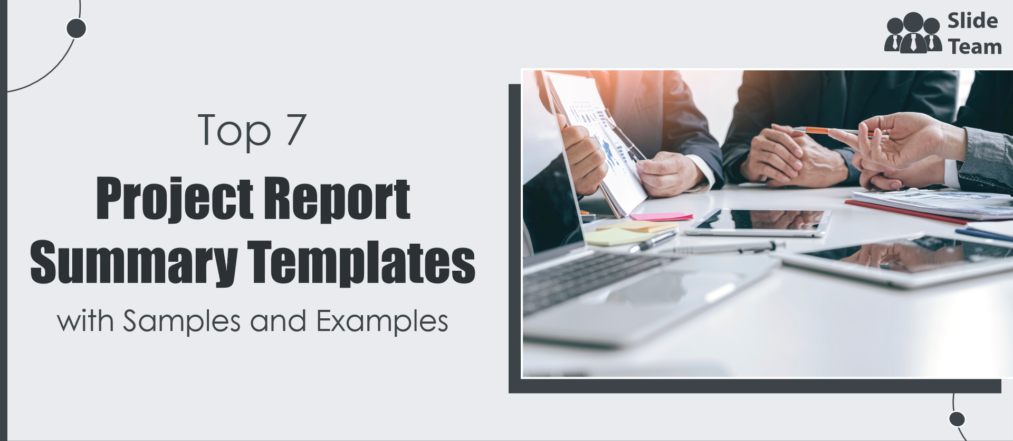
Top 7 Project Report Summary Templates with Samples and Examples

Top 10 One-page Project Summary Templates with Samples and Examples
This form is protected by reCAPTCHA - the Google Privacy Policy and Terms of Service apply.

Digital revolution powerpoint presentation slides

Sales funnel results presentation layouts
3d men joinning circular jigsaw puzzles ppt graphics icons

Business Strategic Planning Template For Organizations Powerpoint Presentation Slides

Future plan powerpoint template slide

Project Management Team Powerpoint Presentation Slides

Brand marketing powerpoint presentation slides

Launching a new service powerpoint presentation with slides go to market

Agenda powerpoint slide show

Four key metrics donut chart with percentage

Engineering and technology ppt inspiration example introduction continuous process improvement

Meet our team representing in circular format

Looking to publish? Meet your dream editor, designer and marketer on Reedsy.
Find the perfect editor for your next book
1 million authors trust the professionals on Reedsy. Come meet them.
Blog • Understanding Publishing
Posted on Sep 12, 2018
How to Write an Incredible Synopsis in 4 Simple Steps
Your novel is fully written, edited, and polished to perfection — you’re ready to pitch it to agents! But you’re missing a critical piece of persuasion: the synopsis. Even after putting together your entire book, you may have no idea how to write one, or even how to approach it.
Luckily, we’ve got answers for you. Read on for our best tips on writing a synopsis that’s clear, concise, captivating… and may even lead to an all-out agent battle over your novel!
What is a synopsis?
A synopsis is a summary of a book that familiarizes the reader with the plot and how it unfolds. Although these kinds of summaries also appear on the pages of school book reports and Wikipedia, this guide will focus on constructing one that you can send out to agents (and eventually publishers).
Your novel synopsis should achieve two things: firstly, it should convey the contents of your book, and secondly, it should be intriguing!
While you don’t need to pull out all the marketing stops at this stage, you should have a brief hook at the beginning and a sense of urgency underlying the text that will keep your reader going. It should make potential agents want to devour your whole manuscript — even though they’ll already know what happens.
While writing your synopsis, make sure that it includes:
- A complete narrative arc
- Your own voice and unique elements of your story
- The ending or resolution ( unlike in a blurb )
As for the ideal length for this piece, it varies from project to project. Some authors recommend keeping it to 500 words, while others might write thousands. However, the standard range is about one to two single-spaced pages (or two to five double-spaced pages). And if you're interested in knowing how to format the whole of your manuscript for submission, we recommend downloading this manuscript format template.

FREE RESOURCE
Manuscript Format Template
Get your manuscript ready for submission to agents and publishers.
You may also want to have an additional “brief” summary prepared for agents who specifically request a single page or less. Remember: as hard as it will be to distill all your hard work into that minimal space, it’s crucial to keep your synopsis digestible and agent-friendly.
How to write a novel synopsis in 4 steps

1. Get the basics down first
When it comes to writing a synopsis, substance is the name of the game. No matter how nicely you dress it up, an agent will disregard any piece that doesn’t demonstrate a fully fleshed out plot and strong narrative arc. So it stands to reason that as you begin writing, you should focus on the fundamentals.
Start with major plot points
Naturally, you want agents to be aware of your story's major plot points . So the best way to start summarizing your story is to create a list of those plot points, including:
- The inciting incident — what sparks the central conflict of your story?
- The events of the rising action — what happens in the interlude between the inciting incident and the climax, and how does this build tension?
- The height of the action, or climax , of your story — this one is the most important, as it should be the most exciting part of your book!
- The resolution or ending — again, unlike a blurb, a synopsis doesn’t need to dangle the carrot of an unknown ending to the reader; you can and should reveal your story’s ending here, as this brings the plot and narrative arc to a close.
Listing these points effectively maps out the action and arc of your story, which will enable the reader to easily follow it from beginning to end.
Include character motivations
The key here is not to get too deep into characterization, since you don’t have much room to elaborate. Instead, simply emphasize character motivations at the beginning and end of your synopsis — first as justification for the inciting incident, then again to bring home the resolution. For example:
Beginning: “Sally has spent the past twenty years wondering who her birth parents are [motivation]. When a mysterious man offers her the chance to find them, she spontaneously buys a ticket to Florence to begin her journey [inciting action].”
Ending: “She returns to the US with the man who was her father all along [resolution], safe in the knowledge that she’ll never have to wonder about him again [restated motivation].”
Also note how the text here is written in third person, present tense, as it should be regardless of the tense or POV of your actual book. Writing a synopsis in first or second person doesn’t really work because it’s not meant to be narrated — just summarized. Basically, the present tense works to engage the reader while the third person allows the story to be told smoothly.
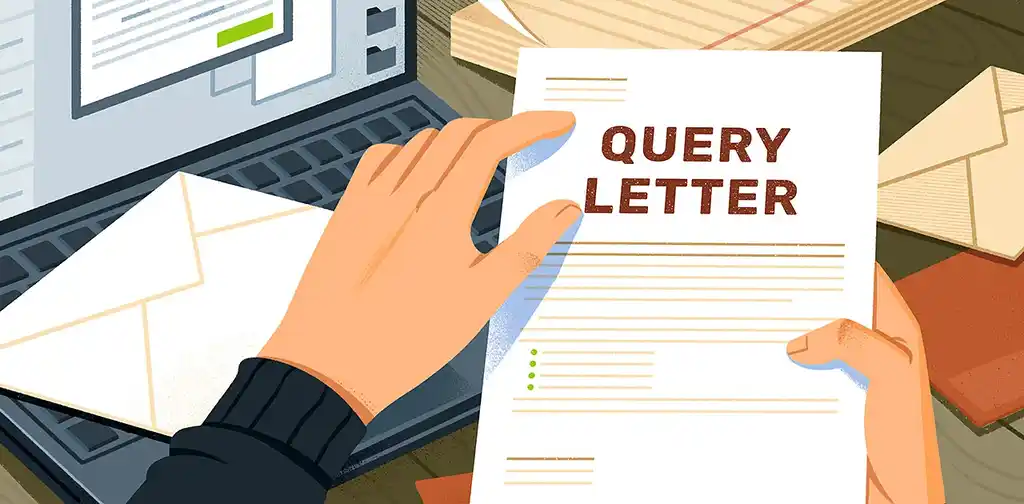
Query Submissions Tracker
Stay organized on your journey to find the right agent or publisher.
2. Highlight what’s unique
Now it’s time to spice up your synopsis by highlighting the elements that make it unique. Agents need to know what’s so special about your book in particular — and moreover, is it special enough to get readers to pick it up? Below are some features you might employ to grab an agent’s attention and assure them of your book’s appeal.
Your writing voice is an essential tool here: it conveys your novel’s tone and is one of the most important factors in making your work stand out. However, it’s also one of the most difficult elements to evoke in such a small amount of space.
The best way to capture voice in a synopsis is through extremely deliberate word choice and sentence structure. So if you were Jane Austen, you’d use clever words to magnify your wit: “When Darcy proposes to her apropos of nothing, Elizabeth has the quite understandable reaction of rejecting him.” You may not be able to use all the elaborate prose of your novel, but your synopsis should still reflect its overall feeling.
Plot twists
Even though they’re one of the oldest tricks in the book, readers will never tire of juicy plot twists. If your novel contains one or more of these twists, especially at the climax, make sure your synopsis accentuates it. But don’t hint too much at the twist, as this will make it seem more dramatic when it comes; a couple of words in the intro will suffice as foreshadowing.
For instance, if you were writing a summary of Gone Girl , you might open with “Nick Dunne wakes up one morning to find that his wife, Amy, has apparently disappeared. ” This implies that she may not be as “gone” as we think she is, setting the stage for the later reveal.

Point of view
Another aspect that might set your book apart is a distinctive point of view . Since you’ll be giving your synopsis in third person, you can limit this inclusion to an introductory sentence: “This book is narrated from the point of view of a mouse.”
Although this strategy works best for books with a highly unusual point of view (such as The Book Thief by Markus Zusak, in which the story is told by Death), it can also be very helpful to remember for seemingly bog-standard narrators. If one of your characters narrates in first person, make sure to address their individual narrative quirks as well as any biases or limitations; highlighting an unreliable narrator can really add to your novel’s intrigue!
3. Edit for clarity and excess
Don’t shroud your synopsis in mystery; this is very frustrating to agents who just want to know what happens in your book! With that in mind, after you’ve written the bulk of your summary, it’s time to edit for clarity. You also may have to delete some text, so you can get it right in that couple-page sweet spot.
Editing for clarity
The paramount rule of synopses is a real doozy: tell, don’t show. It’s the opposite of that classic adage that writers have heard their whole lives, and it’s exactly what you need to write a successful synopsis.
As you return to what you’ve written, scan for sentences that are vague or unclear, especially toward the beginning. Many writers fall into the trap of trying to hook agents by opening with a sentence akin to the first murky line of a literary novel. Again, though you do want your intro to be intriguing, it has to cut to the chase pretty quickly.
When it comes to opening a synopsis, you need to think like Tolkien, not Tolstoy. “In a hole in the ground there lived a hobbit.” Crisp, clear, and to the point: one of the very few times you should tell, rather than show .
Editing excess words
If your synopsis is longer than a couple of pages at this point, you need make some serious cutbacks. Read through what you have, scrutinizing every sentence and word, even if you think you’ve chosen them carefully. Reduce any run-on sentences or subordinate clauses that unnecessarily lengthen your piece.
Finally, eliminate irrelevant details — anything that doesn’t lead to the next plot point or directly contribute to your voice or other distinctive elements. It’s unlikely you’ll have included any of these in the first place, but just in case they’ve slipped through, cut them. Save the frills for your book; remember, your synopsis is all about substance .
4. Make sure it flows
By the time it’s finished, your synopsis should read like a summary from an excellent book review — or at the very least SparkNotes or Shmoop. This means not only clearly and concisely hitting every important point, but also reading in a smooth manner, placing just the right amount of emphasis on the critical moments and unique aspects we’ve discussed.
Get test readers
A great way to ensure that your synopsis is paced precisely and flows well is to give it to test readers, either someone you know or a professional editor . You’ve spent way too much time with these words to be objective about them, so pay attention to what other people suggest: possible word substitutions, transitions, and which details to emphasize versus delete.
Use professional synopses as models
You don’t want to look at examples of other synopses too soon, otherwise yours will come out sounding formulaic and stale. That said, professional synopses can be a very valuable tool for refining toward the end of the process! Compare and contrast them to the synopsis you’ve written, and adapt any techniques or turns of phrase you feel would enhance it.
Here’s an example of a strong (albeit brief) synopsis of Great Expectations by Charles Dickens , courtesy of the Oxford Companion to English Literature:
Phillip Pirrip, more commonly known as “Pip,” has been brought up by his tyrannical sister, wife of the gentle Joe Gargery. He is introduced to the house of Miss Havisham who, half-crazed by the desertion of her lover on her bridal night, has brought up the girl Estella to use her beauty as a means of torturing men. Pip falls in love with Estella and aspires to become a gentleman.
Money and expectations of more wealth come to him from a mysterious source, which he believes to be Miss Havisham. He goes to London, and in his new mode of life meanly abandons the devoted Joe Gargery, a humble connection of whom he is now ashamed.
Misfortunes come upon him. His benefactor proves to be an escaped convict, Abel Magwich, whom he as a boy had helped. Pip’s great expectations fade away and he is penniless. Estella meanwhile marries his sulky enemy Bentley Drummle, by whom she is cruelly ill treated.
In the end, taught by adversity, Pip returns to Joe Gargery and honest labor. He and Estella, who has also learnt her lesson, are finally reunited.

This synopsis works well because it includes:
- The inciting incident (Pip moving in with Miss Havisham), the rising action (him being in London), the climax (returning to Joe Gargery), and the resolution (reuniting with Estella)
- Character motivations (Miss Havisham wants to punish all men because her fiancé betrayed her; Pip wants to become a gentleman so Estella will fall in love with him)
- A plot twist (Pip’s benefactor being a criminal — whom he knows from his childhood!)
- Distinctive voice (formal yet engaging, doesn’t detract from the plot) and smoothly written style (events are chronological and progress quickly)
Your synopsis is one of the biggest deciding factors in whether an agent wants to see more from you or not. No matter how chipper your query letter , the bottom line is that this summary tells agents (and later publishers) what they really need to know: what your book is about, what makes it unique, and most importantly, if they can sell it.

FREE COURSE
How to Write a Query Letter
Learn to grab agents’ attention with 10 five-minute lessons.
That’s why it’s vital that you make your synopsis airtight. Fortunately, if you’ve followed these steps, yours will be chock full of plot details with a touch of your own special writing sauce: a synopsis that any agent (hopefully) won’t be able to resist.
Many thanks to Reedsy editors (and former agents) Sam Brody and Rachel Stout for consulting on this piece!
Do you have any tips for writing an irresistible synopsis? Leave them in the comments below!
2 responses
Elizabeth Westra says:
12/09/2018 – 22:10
This looks interesting, and I will read every word, but this would be different for a picture book. You only get one page to query for many children's books.
Dorothy Potter Snyder says:
14/10/2018 – 20:11
I am curious if anyone has ideas on how translators can write a synopsis for agents / publishers of works in translation? Might there be something about why this author is important in his/her country of origin and literary tradition? Which authors more known to English language readers might relate to this author (they've never heard of before)?
Comments are currently closed.
Continue reading
Recommended posts from the Reedsy Blog

How to Publish a Book For Free: The 7 Best Sites
If you want to publish your book without spending a single dime, check out this handy list of 7 free self-publishing services.
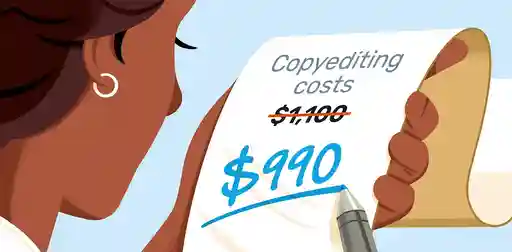
5 Ways to Save on Your Self-Publishing Budget
If you want to self-publish a book without breaking the bank, here are 5 tips to ensure you still get the best result possible.

30 Great Book Dedication Examples to Inspire Your Own
A list of 30 of the best book dedications in the business, that'll have you crying, laughing, and crying laughing.

Expository Writing: The Craft of Sharing Information
Expository writing is a fundamental part of how we learn and make sense of the world. Learn all about it in this post.

Additional Reviews: Query Critique December 2024
Additional critiques from Reedsy's December 2024 query letter session.

How to Make Money by Writing Books: 8 Tips for Success
If you want to be an author who makes a living from books, here are eight tips to help you make money as a writer.
Join a community of over 1 million authors
Reedsy is more than just a blog. Become a member today to discover how we can help you publish a beautiful book.

Bring your publishing dreams to life
The world's best freelance editors, designers, and marketers are on Reedsy. Sign up for free and meet them TODAY.

1 million authors trust the professionals on Reedsy. Come meet them.
Enter your email or get started with a social account:
Filter by Keywords
10 Free Executive Summary Templates in Word, Slides, & ClickUp
Praburam Srinivasan
Growth Marketing Manager
February 14, 2024
Executive summaries are a key part of any business plan and there’s a lot riding on their success!
Despite being a small piece of a larger proposal, executive summaries serve a big purpose in project management and will be read by every stakeholder, higher-up, or investor you hope to impress. So they must be handled with care.
Your executive summary should be short and sweet, but it also needs to pack a punch. Different than an abstract, the executive summary provides a condensed variation of what your project proposal explains in length. Think of it as the highlight reel or SparkNotes version of your more-detailed project documents .
The thing is, executive summaries are all about strategy. They may be brief, but they’re intentional! And there’s a secret to nailing the perfect summary for your proposal every time—templates. 🙂
Executive summary templates are the only surefire way to guarantee you’re hitting the most impactful points, every time. Plus, they help you save time writing them and make the overall process significantly less stressful and more formulaic.
Follow along to learn more about executive summary templates and the must-have features to look for before you download. Even access 10 of the best free executive summary templates for any type of proposal! Whether you use ClickUp, Word, PowerPoint, or the like, we’ve got a template to make your summaries significantly easier. 🙌🏼
What is an Executive Summary Template?
Top features to look for in executive summary templates, 1. clickup executive summary doc template, 2. clickup whiteboard executive summary template, 3. clickup executive memo template, 4. clickup program summary template, 5. clickup payroll summary report template, 6. clickup executive board report template, 7. clickup executive project status report template, 8. microsoft word executive summary template, 9. powerpoint executive summary template, 10. executive summary google slides template, who benefits from using an executive summary template, in summary, choose an executive summary template by clickup.
First things first— what is an executive summary?
An executive summary boils down the key points from a larger report or proposal into a brief and easily digestible document. This summary will give the reader a solid grasp on what’s to come and will cover the main takeaways from the larger body including the project plan , the problem it aims to solve, the project scope , cost breakdowns, OKRs , and more.
The length of your summary will vary depending on the complexity of your project, but a good rule of thumb is to think of it as a “section” rather than a full-length document of its own.
When it comes to executive summaries in project management, here are the five major points to cover in your executive summary:
- Project description : This is how you’re going to hook your reader! Stick to two or three sentences that summarize the project and its purpose.
- The problem you’re solving : Why are you making this product? Use this opportunity to dive into the reasons why people need this solution.
- Market analysis : This includes your target audience, any research you’ve done, and data that helps support why your product will succeed.
- The process : Without going too deep into the workflow, what will it take to get this project off the ground? Describe the resources, budget, people, and time needed to make your project possible.
- Future projections and next steps: What’s in it for the reader? How will this project create profit for those involved and what do the next steps look like to reach the project’s goal ?
That sounds like a lot to remember, right?
So take some of the pressure off of your summary process by investing your time more productively—in a customizable executive summary template that guarantees results! Think of your executive summary template as training wheels on a bike or bumpers at the bowling alley—except everyone uses them, even the most seasoned project managers in the game!
Like other project management templates , these pre-built documents will guide you in the right direction, no matter your budget or project type! The best templates will be easy to use, share, and complement your project management software . That way, your project proposal, summary, workflow, and progress can all exist on the same platform. This not only helps you save time but is crucial for streamlining processes and keeping your management team on the same page.
But what else should you look for in your executive summary template?
We’ve covered the five big sections of every successful executive summary, but what features should you look for in the actual template?
Highly visual : When people think of summaries, it’s easy to think of a blank page. Instead, you should think of your summary as a presentation aid. The more visual, engaging, and interesting your summary looks, the easier it will be for stakeholders to grasp it. Next time you go to open a new document, try looking at digital whiteboard software to take your summary further.
Collaboration tools : Live editing, comments, @mentions, and screen sharing are huge assets for your template. The summary will only get stronger with more eyes on the draft, and collaboration features will help the team work together and present alongside each other without overlap!
Sharing and permissions : Make sure your executive summary is accessible! Not everyone will use the same project management software as your team, but custom sharing and permission options will give you the power to choose who can edit, view, and distribute your work.
Integrations : More integrations will give you the ability to add more context to your summary and make it more valuable in the long run. Embedding, especially! Adding in important data, media, charts, and links will make your summary mean so much more than a simple document.
10 Free Executive Summary Templates You Have to Try
Executive summaries are deceptively short tasks!
While they may be brief in length, a lot of work, strategy, and thought goes into ensuring their success. And since the summary will be viewed by everyone involved and sometimes be the first thing they see, it’s crucial that it’s done correctly every time.
So before you spend another second sweating in front of your multi-page proposal, turn to one of these 10 free executive summary examples to kickstart your strategic messaging.
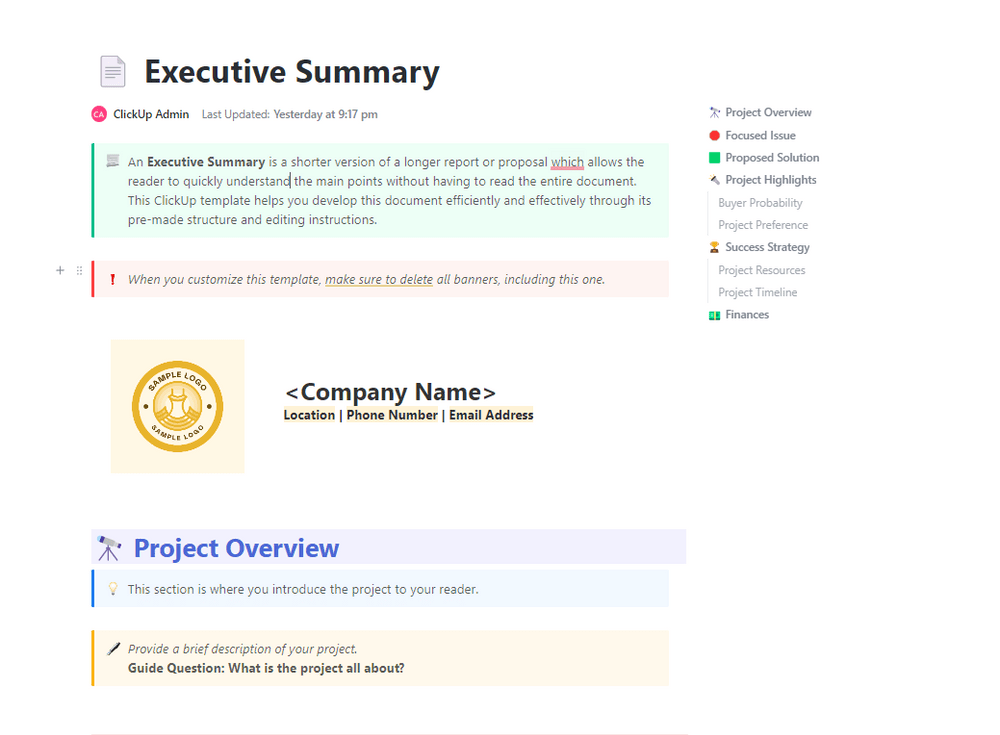
Here’s the ClickUp Executive Summary Doc Template to help you write a compelling teaser for your project proposal. You’ll know exactly what to add with the help of a guiding question at the top of each section. Once you’re finished, delete the questions for a cleaner document! 🤩
You can explain the value proposition of your proposal to your audience (like potential investors) with this template’s interactive features. Provide details about your business plan or project proposal, including the company’s mission statement, goals, project objectives , products, and target market.
The document breaks down key topics into sections, so you won’t have to spend extra time formatting! Template highlights include:
- Project Overview : A brief description of your proposed project
- Focused Issue : The customer feedback or problem the project aims to solve
- Project Highlights : Market analysis results and project strengths
- Finance : Financial projections and requirements
Pro tip : Customize your executive summary template with your branding and basic information. Then, save and apply it to future executive summaries so you’ll always have access to pre-filled documents at a moment’s notice!
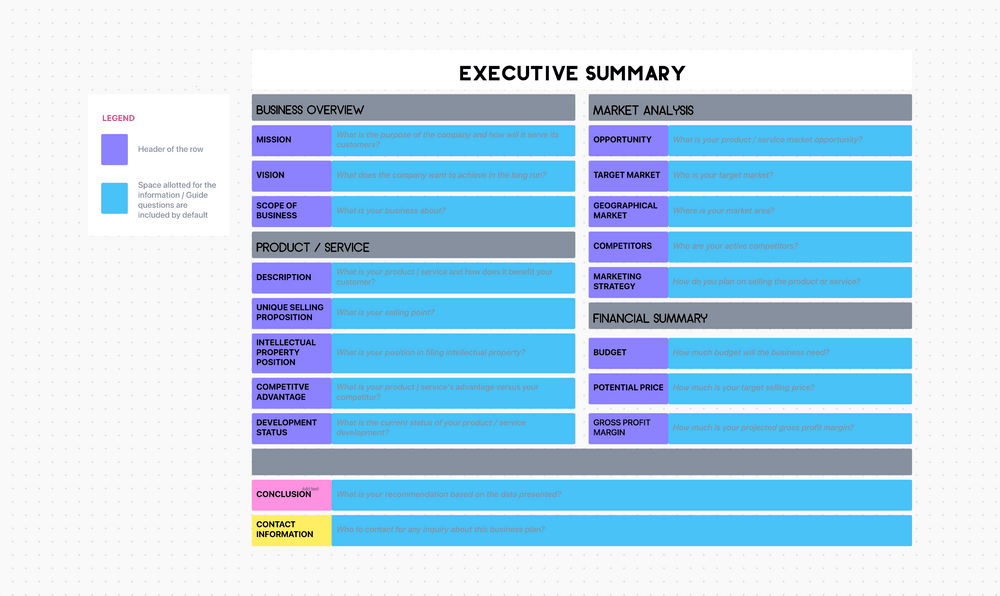
ClickUp’s Whiteboard Executive Summary Template is a perfect tool for project managers who want their executive summary to be an interactive experience that keeps the reader’s attention throughout your pitch.
With a digital whiteboard, you can communicate your ideas visually and make a lasting impression on your audience. You’ll also need a set of productivity tools to organize your thoughts, create charts, annotate images, and assign actionable tasks. 🎯
Enter: ClickUp Whiteboards !
Using ClickUp’s Whiteboard as an executive summary tool, your content can double as a working canvas and an engaging presentation from start to finish.
ClickUp Whiteboards offer embedding, rich text editing, resource linking, and more to make designing executive summaries easier. In its basic form, Whiteboards are made of these powerful elements:
- ClickUp Cards (tasks) you can add to the Whiteboard as you work through your ideas
- Objects (shapes, sticky notes, images)
- Connectors (arrows, lines)
Not sure what steps to take first on your Whiteboard? We got you covered with a Getting Started guide in the template!

Like executive summaries, executive memos are short-form documents containing the latest project information for key stakeholders. The purpose of an executive memo is to communicate important information to the intended audience, such as the status of a project, policies, or cross-functional procedures and processes in the company.
Depending on how often your audience expects an executive memo to arrive in their inbox, you should start building a central wiki where all of your memos will be stored for record-keeping purposes.
The reality is that schedules, deliverables, stakeholders, and collaborators for any given project are likely to change at some point. In some cases, we get so bogged down in work that we neglect to update documentation for days or weeks. 🗓
ClickUp Docs seamlessly integrate into your tasks and projects. You are only a few clicks away from retrieving any documentation to reference or update within the platform.
Try it for free today! Connect the ClickUp Executive Memo Template to workflows by creating nested subpages for each memo in the template and linking the subpages to the memos. Your stakeholders will appreciate the digital trail!

The length of time it takes to complete a program may vary from months to even years. Unlike projects, they’re about the benefits, transformation, and change of the organization. For this proposal type, we can’t use a basic executive summary template!
ClickUp’s Program Summary Template offers you a one-stop shop for creating a high-level overview of the programs you run in the organization. ⚡️
Your program summary document should include the following sections to make it as effective as possible:
- Program name and purpose : Clearly state the name and provide a brief description of its purpose and objectives
- Target audience or beneficiaries : Identify the target audience or beneficiaries of the program or initiative (and any relevant demographic information)
- Key activities and project milestones : Provide an overview of the timeline, including the start and end dates, and major phases
- Measurable outcomes and impact : Identify the measurable outcomes or impact the program is expected to achieve and how it will be evaluated
- Funding and partners : Give information on the funding source and any partners or collaborators involved in the program or initiative
Check out our detailed program management guide for tips, examples, and features for a successful program!

An employee payroll summary report is usually prepared for HR or Finance personnel responsible for processing payrolls. In this report, payroll expenses are summarized for the period of time specified, for example, a month or quarter in the past.
During a payroll review, management will ensure compliance with labor laws and consider the payroll expenses against the budget. There are several uses for the payroll report, including identifying any discrepancies or errors that might occur in the payroll process and tracking the progress of payroll-related projects or initiatives. 📊
You can collaborate with your cross-functional partners with ClickUp’s Payroll Summary Report Template and save the extra time of sending back-and-forth emails! Simply highlight any text to add a comment, or @mention members to call out action items.
Throughout the template, you’ll find organized tables similar to those on a spreadsheet within a ClickUp Doc. Once you have finished editing the template, you will be able to update the Doc’s settings to protect the content and share it with your team.
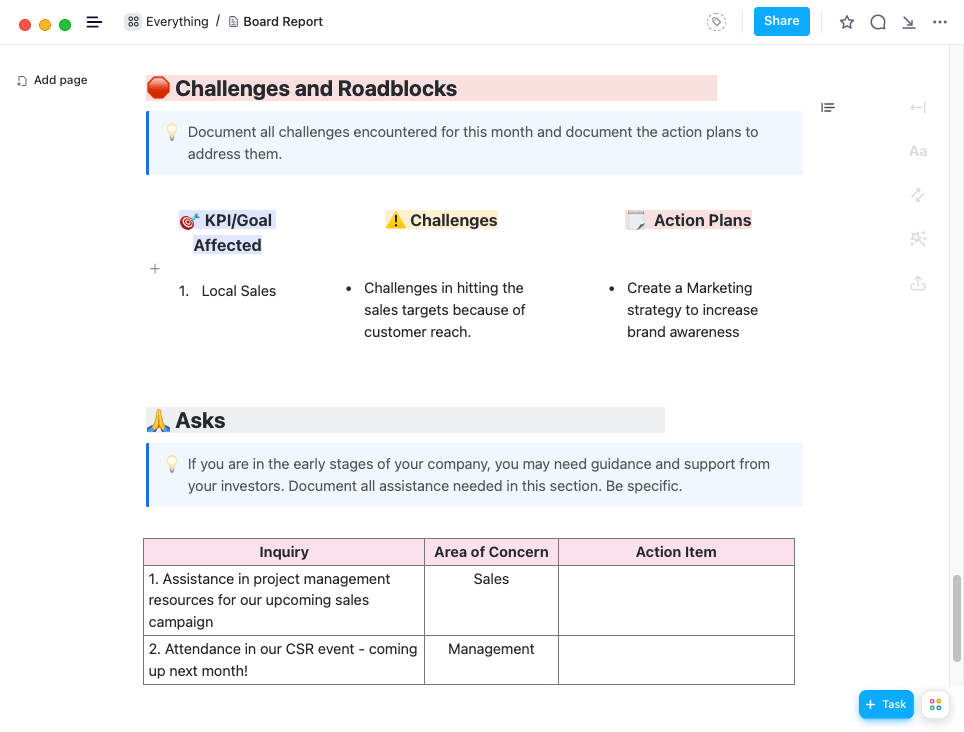
An executive board report is a document that gives an overview of an organization’s progress, performance, strategies, and health. Typically, it contains information about the company’s finances, operations, and goals. The company’s staff and operations are also included if any major changes have been or are about to occur. 🔮
In this ClickUp Executive Board Report Template , you’ll find guiding prompts along with powerful visuals that will help you create a professional report:
- Key Areas of Focus : Project goals that were set at the beginning of the year and a breakdown of month-over-month updates
- Critical Success Factors : Key Performance Indicators (KPIs) relevant and critical to the board
- Financials : Update on the company’s financial health and a breakdown of month-over-month numbers
- Challenges and Action Plans : Tasks in progress to resolve challenges
Download project charter templates to establish your project’s scope!
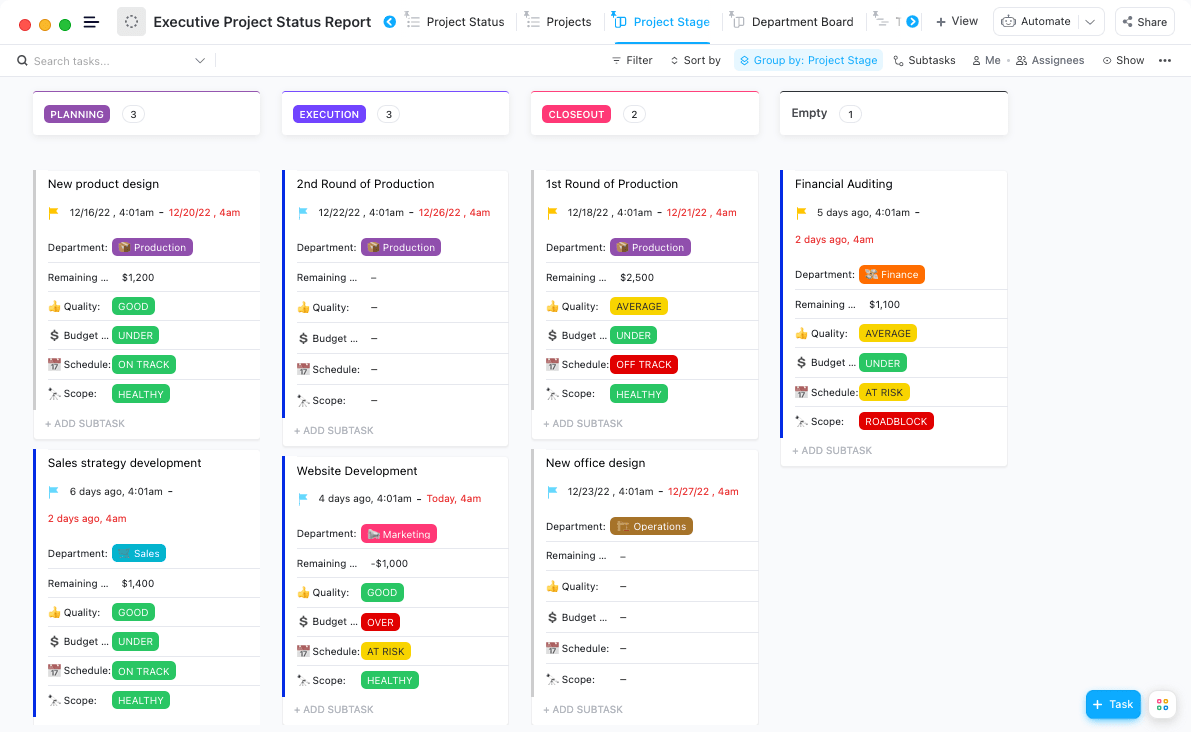
Here’s the ClickUp Executive Project Status Report Template if your executives like to visualize project performance!
By using visualization, complex data and information can be made easier to comprehend and accessible. This is relevant for senior management who may not be actively involved in the day-to-day operations of the project.🛠
The template includes different task views (List, Kanban board, Timeline, and Table) to compare project performance against goals or benchmarks. The results? Better-informed decisions and hours saved from building short-lived reports!
Pro tip : Add a Gantt view to your template and view multiple projects in one place!
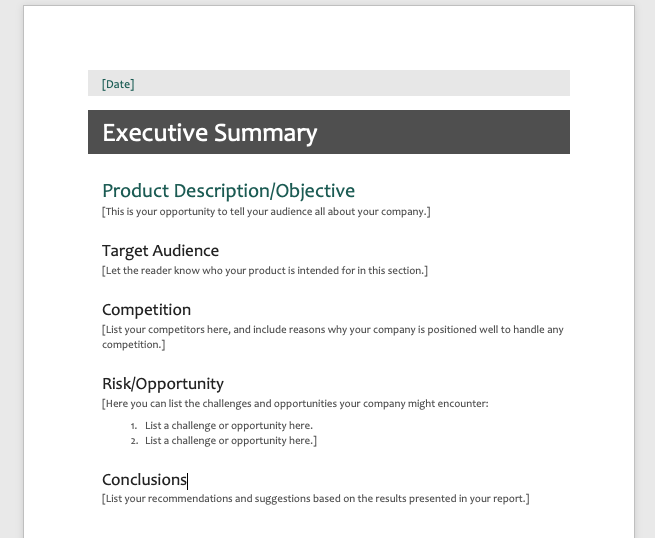
The simple outline in this Word document will help you write an executive summary. It includes sections on business objectives, target audiences, competition, risks, and opportunities, which will guide you in the process of creating your document.
Visuals like charts, diagrams, and graphics engage your audience better than any other type of content, so don’t forget to include them in your document. 🎨
We know building visuals in Word is a time-consuming task, so here are a few guides to help you get the most out of your visual content!
- How to Make a Flowchart in Microsoft Word
- How to Make a Timeline in Microsoft Word
- How to Create a Gantt Chart in Microsoft Word
- How to Make a Mind Map in Word
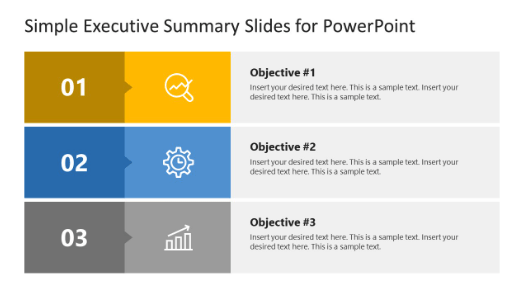
A list of presentation templates wouldn’t be complete without the PowerPoint Executive Summary Template! It’s a three-list design used for presenting business objectives on a one-page slide.
Executive summaries simplify your project proposal content, but you still want to give as much information to your audience, so they get the big picture.
This template would be perfect to use for investors or stakeholders requesting key information in a single snapshot. 📸
Pro tip : A visual alternative would be #2 on this list—the ClickUp Whiteboard Executive Summary Template. As a presenter with a Whiteboard, you have the freedom to transform your presentation from static to interactive with shapes and images!
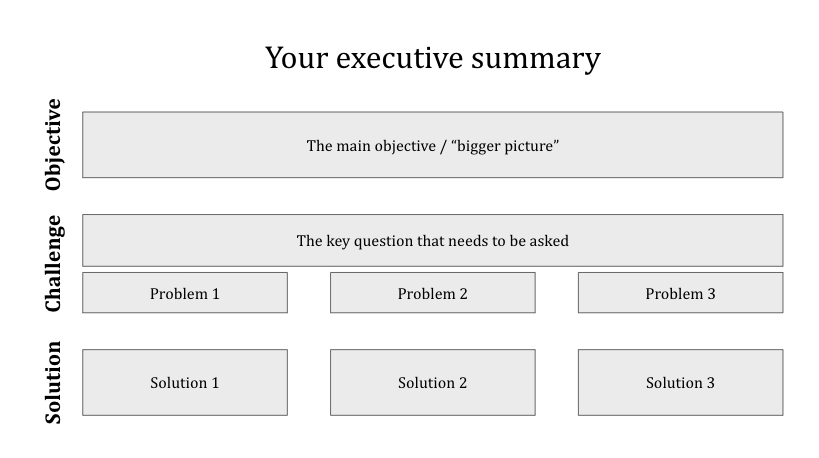
Google Slides is a powerful presentation tool offering a wide range of features and capabilities. Collaborate in real-time with others, embed multimedia, and add animations and transitions! It integrates with other Google products, such as Google Drive, making it easy to access and share presentations. 🔗
The Executive Summary Google Slides Template covers a basic outline to develop an executive summary. Use the sections included or make a list of the important points you want to cover during a meeting . This list could be as simple as the company description, products or services, market analysis, competitive advantage , and financial information.
Entrepreneurs: Start-ups and small businesses can utilize an executive summary to attract potential investors, partners, and customers. The executive summary allows them to comprehensively present their business model, strategies, goals, and overall plan without going into the minute details, thus saving time while still attracting interest.
- Start-up Executive Summary
- Small Business Executive Summary
- Entrepreneurs Executive Summary
Investors: An executive summary is a valuable tool for investors to get an understanding of a business or potential investment opportunity with minimal time expenditure. It highlights the key elements of a business proposal or plan, helping them to make efficient, informed decisions.
- Angel Investor Executive Summary
- Investors Executive Summary
- Real Estate Investors Executive Summary Template
Your executive summary should complement your larger business proposal or report—similar to the way your executive summary template should complement your project management software!
Creating your executive summary with a template designed to boost your productivity will take your effort, team, and project further in the long run. Plus, it will save you important time in the planning process.
Using ClickUp Docs , its Kanban-like Board view , and Whiteboards are just a few of the many ways you can bring your executive summary to life—and templates make the experience even smoother! But the best part? You can take your next steps directly from the summary itself, making your entire document more valuable throughout the entire project process.
ClickUp is the only productivity platform powerful enough to bring all of your work together across apps into one centralized hub. With over 15 highly visual ways to build your workflow, a rich set of features , over 1,000 integrations , and hundreds of customizable templates for every use case, ClickUp creates solutions for teams of any size and every pricing plan .
Access ClickUp Docs, Whiteboards, Board view, unlimited tasks, and so much more when you sign up for ClickUp today.
Questions? Comments? Visit our Help Center for support.
Receive the latest WriteClick Newsletter updates.
Thanks for subscribing to our blog!
Please enter a valid email
- Free training & 24-hour support
- Serious about security & privacy
- 99.99% uptime the last 12 months
- PRO Courses Guides New Tech Help Pro Expert Videos About wikiHow Pro Upgrade Sign In
- EDIT Edit this Article
- EXPLORE Tech Help Pro About Us Random Article Quizzes Request a New Article Community Dashboard This Or That Game Popular Categories Arts and Entertainment Artwork Books Movies Computers and Electronics Computers Phone Skills Technology Hacks Health Men's Health Mental Health Women's Health Relationships Dating Love Relationship Issues Hobbies and Crafts Crafts Drawing Games Education & Communication Communication Skills Personal Development Studying Personal Care and Style Fashion Hair Care Personal Hygiene Youth Personal Care School Stuff Dating All Categories Arts and Entertainment Finance and Business Home and Garden Relationship Quizzes Cars & Other Vehicles Food and Entertaining Personal Care and Style Sports and Fitness Computers and Electronics Health Pets and Animals Travel Education & Communication Hobbies and Crafts Philosophy and Religion Work World Family Life Holidays and Traditions Relationships Youth
- Browse Articles
- Learn Something New
- Quizzes Hot
- This Or That Game
- Train Your Brain
- Explore More
- Support wikiHow
- About wikiHow
- Log in / Sign up
- Education and Communications
- Writing Techniques
- Planning Your Writing
How to Write a Synopsis
Last Updated: April 18, 2024 Fact Checked
This article was co-authored by Richard Perkins . Richard Perkins is a Writing Coach, Academic English Coordinator, and the Founder of PLC Learning Center. With over 24 years of education experience, he gives teachers tools to teach writing to students and works with elementary to university level students to become proficient, confident writers. Richard is a fellow at the National Writing Project. As a teacher leader and consultant at California State University Long Beach's Global Education Project, Mr. Perkins creates and presents teacher workshops that integrate the U.N.'s 17 Sustainable Development Goals in the K-12 curriculum. He holds a BA in Communications and TV from The University of Southern California and an MEd from California State University Dominguez Hills. There are 12 references cited in this article, which can be found at the bottom of the page. This article has been fact-checked, ensuring the accuracy of any cited facts and confirming the authority of its sources. This article has been viewed 363,170 times.
A synopsis is an in-depth summary of a written work that describes the content of that work from beginning to end. Unlike a summary, which just gives a general overview of a story, a synopsis contains all of the plot details, including the end. Typically, synopses are submitted to publishers or agents after you have written a novel, screenplay, or other long work. A good synopsis will cover the main conflict and the resolution of the story while describing the emotional development of the main character. It is important to edit your synopsis carefully, as it will usually be included as part of a larger proposal.
Outlining Your Synopsis

- Established authors who have published before may be able to get away with submitting an incomplete book proposal, but most new authors will need a full manuscript.
- You will need to know how the story ends to write the synopsis, as a synopsis will include the resolution of the story.
- Make sure each of your characters is dynamic, rather than flat. They all need to be well-rounded and capable of change. Additionally, each character should impact the story in a significant way.

- If you wrote a screenplay or play, make a list of what happens in each act. You can write, "Rory enters the warehouse, and a shootout ensues."
- If you have a collection of short stories or poetry, identify the main themes of each work. For example, you might state, "This collection explores memory, childhood, and innocence."

- Does your story have an interesting point of view? If so, be sure to mention it. You can say, “This story centers around the last dwarf in the underground kingdom.”
- Does your story have a unique twist? You can mention the twist while still leaving some mystery. For example, you might say, “Jean Paul soon realizes that the murderer may be closer to him than he thinks.”
- Does your story fulfill a certain niche in the market? You might want to demonstrate who might be interested in this story. For example, you can write, “This memoir explores what it means to be a member of the lost generation.”

- Novel synopses are usually between two and twelve pages long.
- Screenplay synopses are usually one page long. Most are no more than 400 words long.
Drafting the Synopsis

- Most film production companies and some book publishers may ask you to capitalize every letter of a character's name. For example, you would write "JENNA" instead of "Jenna."

- For example, you might start the paragraph by saying, “When her plane crashes in the isolated reaches of the Amazon rainforest, Laura realizes that to survive, she must first overcome her inner demons.”
- As you introduce other characters, you should introduce them in relation to the main character. For example, you might write, “Laura is joined by the only other survivor, a mysterious archaeologist named Terry.”

- Don't go into too much detail about subplots and minor actions. You don't want your synopsis to be confusing, so focus on the main story line.
- For example, you might write, "After James beats the river monster, he continues on to find the magic crystal. When he locates the cave, he finds it blocked. He agrees to trade his sword to a goblin in exchange for help."

- You might say, "Jun discovers that Ginny had stolen the diamond. The movie concludes with the police arresting Ginny."

- Don’t include dialogue in your synopsis. Instead, just summarize what the characters said.
- Refer to minor characters by their role, not by their name. Instead of saying, “Lewis, a saxophonist who Joe encounters one night” you might write, “Joe meets a saxophonist.”

- For example, you might write, “Invigorated by her new discovery, Cecilia rushes to contact Horatio, only to be shocked when she learns that he is already dead.”

- Do not use phrases like “in one tear jerking scene” or “in a stunning flashback.” Simply describe the scenes as they happen. If you want to describe emotions you're hoping to convey in your work, focus on how your characters react to certain events, not how you expect the reader to react. For example, "When Claire realizes the truth, she becomes disillusioned."
- Don’t assume what readers will feel. For example, don't say “Readers will gasp as they discover what Lord Melvin has in store for Lady Betty.” Instead, you might write, “As Lady Betty travels through the castle, she slowly realizes Lord Melvin’s intentions.”
Editing Your Synopsis

- If you don't have guidelines, you should include your name and the title of your work at the top of every page.
- Always use one-inch margins when submitting work for publication.

- Try reading your entire synopsis out loud to catch any mistakes.
- You can hire a copyeditor to proofread it for you.

- For example, one publishing house may require you to cut down your synopsis to one page. In this case, focus on just the main conflict. Another may ask for four pages. In this one, you can go into more detail.
- If you do not tailor your synopsis to a publisher, they may not read your submission.

- A query letter should contain a short summary of your work, a brief paragraph explaining your credentials, and a reason why the agent should accept your submission.
- A sample may include one or two chapters, one act of a screenplay, or one short story out of a collection. In most cases, it will be the first scene or chapter.

Put time and effort into pitch materials. "Above all, a query letter is a sales pitch and it is the single most important page an unpublished writer will ever write. It's the first impression and will either open the door or close it. It's that important, so don't mess it up. Mine took 17 drafts and two weeks to write."
Sample Synopses

Expert Q&A

You Might Also Like

- ↑ https://www.spreadtheword.org.uk/a-pocket-guide-to-writing-a-synopsis/
- ↑ Richard Perkins. Writing Coach & Academic English Coordinator. Expert Interview. 1 September 2021.
- ↑ https://writingnsw.org.au/support/resources-for-writers/resource-sheets/writing-a-synopsis/
- ↑ https://www.ncl.ac.uk/academic-skills-kit/assessment/assignment-types/writing-a-synopsis/
- ↑ https://examples.yourdictionary.com/synopsis-examples.html
- ↑ https://careertrend.com/how-2079740-format-synopsis.html
- ↑ https://research.ewu.edu/writers_center_revising_paper
- ↑ https://www.chronicle.com/article/the-less-obvious-elements-of-an-effective-book-proposal/
- ↑ https://mitpress.mit.edu/submitting-book-proposal/
About This Article

To write a synopsis, start by creating an outline that includes main characters and plot points so that you can cover the narrative arc of the story. Then, in the first paragraph of your synopsis, introduce your main characters and a general summary of the entire plot, like the conflict the main character must overcome. Next, summarize the main events, like obstacles the character faced and how they overcame them, and be sure to write your synopsis in the third person. Finally, leave the reader with a resolution of the story so they know how it ends. To learn how to edit your synopsis using general guidelines, read on! Did this summary help you? Yes No
- Send fan mail to authors
Reader Success Stories
Alicia Williamson
Apr 20, 2017
Did this article help you?

Nancy Visco
Dec 13, 2017
Elena Starr
Feb 6, 2020
Jun 8, 2023
Aug 4, 2017

Featured Articles

Trending Articles

Watch Articles

- Terms of Use
- Privacy Policy
- Do Not Sell or Share My Info
- Not Selling Info
Don’t miss out! Sign up for
wikiHow’s newsletter

- Scriptwriting
How to Write a Compelling Movie Synopsis [with FREE Synopsis Template]
G ot a great script idea in your head but not sure how to condense it? That’s why you need a synopsis. But what if you don’t know how to write a synopsis?
As a writer, being able to write a movie synopsis (or one for your TV pilot) is a critical skill. Producers, execs, and agents will often want to read a synopsis before diving into the actual script. And frequently it’s the brief synopsis that convinces them to read your script in the first place.
In this article, we’ll answer, “what is a synopsis.” We’ll also give you solid film synopsis examples, and teach you how to write a synopsis with our free synopsis template.
- When to Use a Synopsis ?
- How to Write a Synopsis ?
- The Do's of Writing a Movie Synopsis
- The Don’ts of Writing a Film Synopsis
- A Synopsis Is a Summary
WHAT IS A SYNOPSIS
1. when to use a synopsis.
Whether it's an epic TV series like Game of Thrones or a rom-com that never leaves one square block in New York City, the brief synopsis has to explain it all.
And explain it quickly.
But how quickly? How long is a synopsis?
And what is a synopsis in the first place? How can you find a good film synopsis example?
We’ll answer all these questions.
Let’s start with the basics. What's a synopsis?
SYNOPSIS DEFINITION
What is a synopsis.
A synopsis is a write-up that describes the plot and world of your story. A script synopsis can be used to sell your idea. A synopsis can also be written when providing screenplay coverage or script analysis to agents, managers, and producers.
You can write a brief synopsis or a long synopsis, depending on the goal. Usually, movie synopsis length is one page or less.
As we explore how to write a synopsis, keep in mind that the key here is brevity.
If it's too short, your movie synopsis is really a logline. If it's too long, it goes into outline or treatment territory.
How do you write a synopsis for Incredibles 2? Hit all the beats quickly
A movie synopsis should explain who is the main character (or characters), what they want, and who or what stands in their way.
It should also function as a plot synopsis in that it should describe broad strokes of what the characters do in an effort to get what they want.
writing a compelling synopsis
2. how to write a synopsis.
So how DO you differentiate your synopsis from a logline or an outline?
A good chunk of it comes down to length. Use our synopsis template to keep yours at the proper length.
Loglines barely cover two sentences. Ideally, they stay at about one.
Outlines can go upwards of five to even ten pages. And treatments can run even longer, breaching the teens.
The reason why outlines and treatments can go so long is that they’re a scene-by-scene breakdown written in prose.
An outline or treatment is obviously not a novel, but basic concepts and actions of every scene need to be covered.
Write already! A brief synopsis is a summary, a showcase, and a key to unlock your story
When you’re writing a synopsis, you should stay to one page or less — not a word longer.
Let’s get into the nitty gritty of writing a synopsis right now.
Related Posts
- Learn how to write an outline →
- Get tips on how to write a film treatment like a pro →
- Break down a script with professional production software →
WRITING A SYNOPSIS
3. the do's of writing a movie synopsis.
Learning how to write a movie synopsis isn’t rocket science.
Sure, the film synopsis for Armageddon probably mentioned rocket science, but writing a synopsis isn’t nearly as hard as landing a drill on an asteroid hurtling toward Earth.
At least it doesn’t have to be.
What is a synopsis? Sometimes it’s a rocket ride.
Here’s a list of everything you should take into account when figuring out how to write a synopsis for your project.
- Length : Keep your synopsis to one page. Anything longer than that and it defeats the point of writing a synopsis.
- Tone and Voice: Your movie synopsis should be written in the present tense, third person. Tell the story in the same tone and voice as the script.
- Characters: Make sure you introduce each character with something unique about them, whether it's a physical feature or another idiosyncrasy. The reader should know exactly who each character is, what they want, and why they want it.
- Dialogue : Should a movie synopsis include dialogue? Absolutely. Should it be whole paragraph chunks? Absolutely not. Dialogue should be included in short bursts, used as a way to add color to the characters in the plot synopsis.
- The Ending : What is a synopsis if it doesn't end? The goal here isn’t to flesh out the trailer, so don't keep any secrets when writing your movie synopsis.
These are the priority items on your "how to write a synopsis" to-do list. But to really elevate it, here are more tips to make yours stick out.
- Start with the active drive. Right off the bat, your movie synopsis should clearly explain what the main character wants and what they're doing about it.
- Establish causality . No story exists in a vacuum. So in your film synopsis, make sure the causality from one event to another is explained. Imagine that the words "therefore" and "but" are between each major plot point.
- Start big, end bigger . Your first paragraphs should really hook in the reader with a compelling introduction of your hero. The ending should be even more exciting and tie all the loose ends together.
Now, take all these tips into account and complete the exercise below. It'll strengthen your writing and give you confidence you can use:
SYNOPSIS DRILL
Want to know how to write a synopsis for your movie? Practice is key. Flex your synopsis-writing muscles by choosing two films (or TV shows) that you've recently watched, or that you've always loved. Write a one-page synopsis of each project.
Don't overthink, don't second-guess, and limit yourself to one page for each title. When you've finished, compare the two. Which synopsis is stronger? Are there any points you've missed? How could they be strengthened? What works in each one, and what doesn't? Congratulations — you've got two short synopsis examples under your belt.
The best way to learn how to write a synopsis is to write a synopsis. After you complete the above exercise, you'll come into writing your own synopsis with practical experience and open eyes. As a result, the process won't be unfamiliar, and your work will be stronger.
- Learn how to energize your story with conflict →
- Find out how to write the best character arcs →
- Start shot listing and storyboarding right away →
Best practices when writing A Film SYNOPSIS
4. the don’ts of writing a film synopsis.
Now that you know how to write a synopsis, let's take a look at how to avoid common mistakes.
While there are no hard and fast rules to answer what is a synopsis, it's best to avoid the following errors when writing one:
- Don’t mention too many characters. We don't need the backstory on the waitress at the bar where the two main characters talk. A brief synopsis means you have to let go of these unnecessary elements.
- Don't use too much detail about plot twists and turns. If you explain what someone does and why in your movie synopsis, the twists and turns will make sense to the reader.
- Don't editorialize your film synopsis. We don't need flowery, superfluous language like "in a poignant scene" or "like two star-crossed lovers." Get to the point quickly and clearly.
- Don't make it a marketing tool. Writing a synopsis shouldn't be like writing a pitch deck or a creative brief. A movie synopsis should be a preview of what the story is and who's in it, that way the reader can see how you executed and wrote the story.
- Don't rush to the end . As we said earlier, a brief synopsis should be your goal, but it can be hard to learn how to write a synopsis if you don't have any meat in the middle. That great ending won’t pay off if we don’t know or understand the journey to get there.
When it comes down to how to write a synopsis (and figuring what is a synopsis) the best bet is to tackle the basics of the story head-on.
Save the literary flourishes for the actual script and keep it to the meat and potatoes of the story. The goal here is to provide a brief synopsis, a basic plot synopsis.
You’ll expand and get into nuance and dialogue later, when you actually write the script.
FREE Download: Movie Synopsis Template
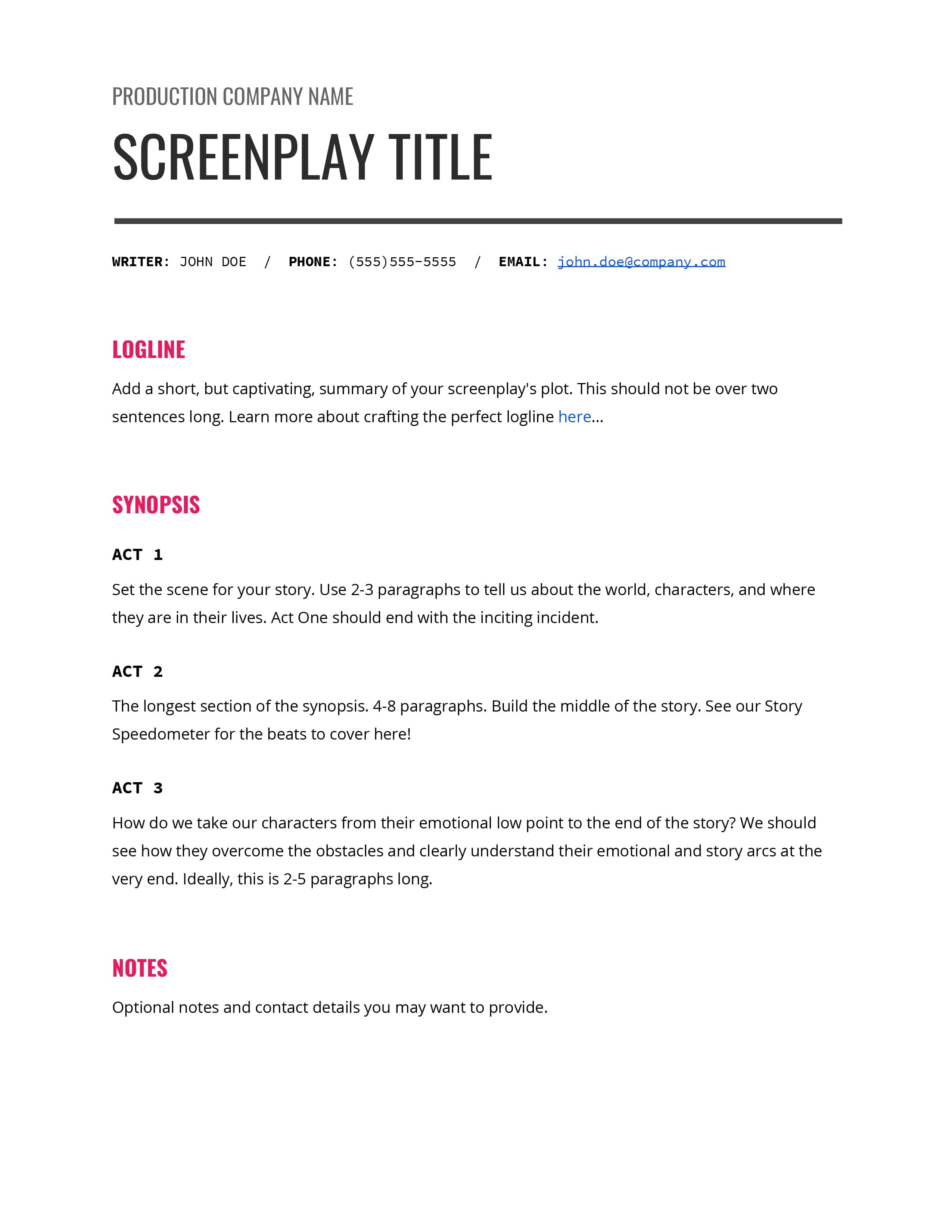
Write your movie synopsis more effectively with our FREE Movie Synopsis template. Enter your email address to receive it instantly.
HOW TO WRITE A SYNOPSIS FOR A MOVIE
5. a synopsis is a summary.
Let’s summarize our synopsis guidance.
How to write a synopsis comes down to a few things.
What is a synopsis?
A synopsis is a one-page write-up that explains the basic plot and world of your project. Who’s who, what’s what, and why should we care.
Who writes a movie synopsis?
Well, the writer definitely should. But also readers.
If anyone is covering an agent's or an executive's desk, they're going to break down and analyze dozens of scripts. Doing so will require writing a clear, brief synopsis for every project.
We have provided solid rules about best practices when writing a synopsis.
But even after you’ve written a good synopsis , make sure your story is structurally sound before moving into the outline, treatment, and script phases.
Using templates and techniques like story circle can help ensure any writer that the structure of their script leads to a dynamic narrative.
That way, when you start figuring out how to write a synopsis for a project, you won't have to worry about any dragging or lagging elements.
After all, no one wants to read a soggy second act. A good synopsis, written with our free template as a guide, will kickstart your storytelling process on the right foot.
How to Write Script Coverage
As you see now, synopses are mainstays on both sides of the industry — business and creative. That's a clear indicator of their importance and why you need to be able to answer the question: what is a synopsis?
More importantly, if you’re a storyteller, you need to know how to write a synopsis.
Now that we’ve given you the tools to write a synopsis, it’s time to learn how to analyze a script. Take it to the next level and find out how to write screenplay coverage like a professional industry reader.
Up Next: How to Write Script Coverage →
Write and produce your scripts all in one place..
Write and collaborate on your scripts FREE . Create script breakdowns, sides, schedules, storyboards, call sheets and more.
- Pricing & Plans
- Product Updates
- Featured On
- StudioBinder Partners
- The Ultimate Guide to Call Sheets (with FREE Call Sheet Template)
- How to Break Down a Script (with FREE Script Breakdown Sheet)
- The Only Shot List Template You Need — with Free Download
- Managing Your Film Budget Cashflow & PO Log (Free Template)
- A Better Film Crew List Template Booking Sheet
- Best Storyboard Softwares (with free Storyboard Templates)
- Movie Magic Scheduling
- Gorilla Software
- Storyboard That
A visual medium requires visual methods. Master the art of visual storytelling with our FREE video series on directing and filmmaking techniques.
We’re in a golden age of TV writing and development. More and more people are flocking to the small screen to find daily entertainment. So how can you break put from the pack and get your idea onto the small screen? We’re here to help.
- Making It: From Pre-Production to Screen
- How to Get a Film Permit — A Step-by-Step Breakdown
- How to Make a Storyboard — Ultimate Guide with Free Storyboard Templates
- VFX vs. CGI vs. SFX — Decoding the Debate
- What is a Freeze Frame — The Best Examples & Why They Work
- TV Script Format 101 — Examples of How to Format a TV Script
- 898 Facebook
- 1.8K Pinterest
- 28 LinkedIn
Home Collections Market Executive summary
Executive Summary Presentation Templates
Make your executive summaries stand out with our executive summary powerpoint templates and google slides themes. crafted for clarity and impact, our 100% editable designs help you highlight key points and present data persuasively. ideal for professionals aiming to impress free downloads are available. make every summary an opportunity to excel..
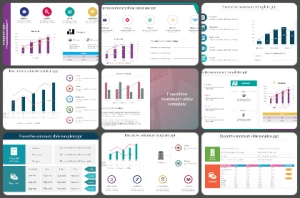
We're here to help you!
What is an executive summary.
An Executive Summary is a brief and clear overview of a larger document prepared for business purposes, such as business plans, company descriptions, investment or project proposals, financial information, market analysis, etc.
What are Executive Summary Presentation Templates?
An Executive Summary Presentation Template can help you present the key components related to your business in a summarized form. It will deliver your content appealingly to unlock new business opportunities.
Where can we use these Executive Summary Slides?
Every business can use these Executive Summary Slides to give a quick overview of essential information to the stakeholders and investors.
How can I make Executive Summary Slides in a presentation?
You can make creative Executive Summary Slides with innovative infographics, charts, and tables to make your summary easy to follow. Our tips and tutorial page will guide you to design the best presentation from scratch.
Who can use Executive Summary Presentation Templates?
CEOs, business executives, department heads, and supervisors can use Executive Summary Presentation Templates to present the summary.
Why do we need Executive Summary Presentation Slides?
Executive Summary Presentation Slides can help you deliver a summary of a larger document clearly and precisely to persuade decision-makers.
Where can I find Executive Summary Presentation Templates for Free?
You can search the internet to find a collection of Free slides for your needs. SlideEgg also has a cluster of 80+ Executive Summary Presentation Templates to help to prepare professional-looking presentations.
A .gov website belongs to an official government organization in the United States.
A lock ( ) or https:// means you've safely connected to the .gov website. Share sensitive information only on official, secure websites.
- About Adverse Childhood Experiences
- Risk and Protective Factors
- Program: Essentials for Childhood: Preventing Adverse Childhood Experiences through Data to Action
- Adverse childhood experiences can have long-term impacts on health, opportunity and well-being.
- Adverse childhood experiences are common and some groups experience them more than others.

What are adverse childhood experiences?
Adverse childhood experiences, or ACEs, are potentially traumatic events that occur in childhood (0-17 years). Examples include: 1
- Experiencing violence, abuse, or neglect.
- Witnessing violence in the home or community.
- Having a family member attempt or die by suicide.
Also included are aspects of the child’s environment that can undermine their sense of safety, stability, and bonding. Examples can include growing up in a household with: 1
- Substance use problems.
- Mental health problems.
- Instability due to parental separation.
- Instability due to household members being in jail or prison.
The examples above are not a complete list of adverse experiences. Many other traumatic experiences could impact health and well-being. This can include not having enough food to eat, experiencing homelessness or unstable housing, or experiencing discrimination. 2 3 4 5 6
Quick facts and stats
ACEs are common. About 64% of adults in the United States reported they had experienced at least one type of ACE before age 18. Nearly one in six (17.3%) adults reported they had experienced four or more types of ACEs. 7
Preventing ACEs could potentially reduce many health conditions. Estimates show up to 1.9 million heart disease cases and 21 million depression cases potentially could have been avoided by preventing ACEs. 1
Some people are at greater risk of experiencing one or more ACEs than others. While all children are at risk of ACEs, numerous studies show inequities in such experiences. These inequalities are linked to the historical, social, and economic environments in which some families live. 5 6 ACEs were highest among females, non-Hispanic American Indian or Alaska Native adults, and adults who are unemployed or unable to work. 7
ACEs are costly. ACEs-related health consequences cost an estimated economic burden of $748 billion annually in Bermuda, Canada, and the United States. 8
ACEs can have lasting effects on health and well-being in childhood and life opportunities well into adulthood. 9 Life opportunities include things like education and job potential. These experiences can increase the risks of injury, sexually transmitted infections, and involvement in sex trafficking. They can also increase risks for maternal and child health problems including teen pregnancy, pregnancy complications, and fetal death. Also included are a range of chronic diseases and leading causes of death, such as cancer, diabetes, heart disease, and suicide. 1 10 11 12 13 14 15 16 17
ACEs and associated social determinants of health, such as living in under-resourced or racially segregated neighborhoods, can cause toxic stress. Toxic stress, or extended or prolonged stress, from ACEs can negatively affect children’s brain development, immune systems, and stress-response systems. These changes can affect children’s attention, decision-making, and learning. 18
Children growing up with toxic stress may have difficulty forming healthy and stable relationships. They may also have unstable work histories as adults and struggle with finances, jobs, and depression throughout life. 18 These effects can also be passed on to their own children. 19 20 21 Some children may face further exposure to toxic stress from historical and ongoing traumas. These historical and ongoing traumas refer to experiences of racial discrimination or the impacts of poverty resulting from limited educational and economic opportunities. 1 6
Adverse childhood experiences can be prevented. Certain factors may increase or decrease the risk of experiencing adverse childhood experiences.
Preventing adverse childhood experiences requires understanding and addressing the factors that put people at risk for or protect them from violence.
Creating safe, stable, nurturing relationships and environments for all children can prevent ACEs and help all children reach their full potential. We all have a role to play.
- Merrick MT, Ford DC, Ports KA, et al. Vital Signs: Estimated Proportion of Adult Health Problems Attributable to Adverse Childhood Experiences and Implications for Prevention — 25 States, 2015–2017. MMWR Morb Mortal Wkly Rep 2019;68:999-1005. DOI: http://dx.doi.org/10.15585/mmwr.mm6844e1 .
- Cain KS, Meyer SC, Cummer E, Patel KK, Casacchia NJ, Montez K, Palakshappa D, Brown CL. Association of Food Insecurity with Mental Health Outcomes in Parents and Children. Science Direct. 2022; 22:7; 1105-1114. DOI: https://doi.org/10.1016/j.acap.2022.04.010 .
- Smith-Grant J, Kilmer G, Brener N, Robin L, Underwood M. Risk Behaviors and Experiences Among Youth Experiencing Homelessness—Youth Risk Behavior Survey, 23 U.S. States and 11 Local School Districts. Journal of Community Health. 2022; 47: 324-333.
- Experiencing discrimination: Early Childhood Adversity, Toxic Stress, and the Impacts of Racism on the Foundations of Health | Annual Review of Public Health https://doi.org/10.1146/annurev-publhealth-090419-101940 .
- Sedlak A, Mettenburg J, Basena M, et al. Fourth national incidence study of child abuse and neglect (NIS-4): Report to Congress. Executive Summary. Washington, DC: U.S. Department of Health an Human Services, Administration for Children and Families.; 2010.
- Font S, Maguire-Jack K. Pathways from childhood abuse and other adversities to adult health risks: The role of adult socioeconomic conditions. Child Abuse Negl. 2016;51:390-399.
- Swedo EA, Aslam MV, Dahlberg LL, et al. Prevalence of Adverse Childhood Experiences Among U.S. Adults — Behavioral Risk Factor Surveillance System, 2011–2020. MMWR Morb Mortal Wkly Rep 2023;72:707–715. DOI: http://dx.doi.org/10.15585/mmwr.mm7226a2 .
- Bellis, MA, et al. Life Course Health Consequences and Associated Annual Costs of Adverse Childhood Experiences Across Europe and North America: A Systematic Review and Meta-Analysis. Lancet Public Health 2019.
- Adverse Childhood Experiences During the COVID-19 Pandemic and Associations with Poor Mental Health and Suicidal Behaviors Among High School Students — Adolescent Behaviors and Experiences Survey, United States, January–June 2021 | MMWR
- Hillis SD, Anda RF, Dube SR, Felitti VJ, Marchbanks PA, Marks JS. The association between adverse childhood experiences and adolescent pregnancy, long-term psychosocial consequences, and fetal death. Pediatrics. 2004 Feb;113(2):320-7.
- Miller ES, Fleming O, Ekpe EE, Grobman WA, Heard-Garris N. Association Between Adverse Childhood Experiences and Adverse Pregnancy Outcomes. Obstetrics & Gynecology . 2021;138(5):770-776. https://doi.org/10.1097/AOG.0000000000004570 .
- Sulaiman S, Premji SS, Tavangar F, et al. Total Adverse Childhood Experiences and Preterm Birth: A Systematic Review. Matern Child Health J . 2021;25(10):1581-1594. https://doi.org/10.1007/s10995-021-03176-6 .
- Ciciolla L, Shreffler KM, Tiemeyer S. Maternal Childhood Adversity as a Risk for Perinatal Complications and NICU Hospitalization. Journal of Pediatric Psychology . 2021;46(7):801-813. https://doi.org/10.1093/jpepsy/jsab027 .
- Mersky JP, Lee CP. Adverse childhood experiences and poor birth outcomes in a diverse, low-income sample. BMC pregnancy and childbirth. 2019;19(1). https://doi.org/10.1186/s12884-019-2560-8 .
- Reid JA, Baglivio MT, Piquero AR, Greenwald MA, Epps N. No youth left behind to human trafficking: Exploring profiles of risk. American journal of orthopsychiatry. 2019;89(6):704.
- Diamond-Welch B, Kosloski AE. Adverse childhood experiences and propensity to participate in the commercialized sex market. Child Abuse & Neglect. 2020 Jun 1;104:104468.
- Shonkoff, J. P., Garner, A. S., Committee on Psychosocial Aspects of Child and Family Health, Committee on Early Childhood, Adoption, and Dependent Care, & Section on Developmental and Behavioral Pediatrics (2012). The lifelong effects of early childhood adversity and toxic stress. Pediatrics, 129(1), e232–e246. https://doi.org/10.1542/peds.2011-2663
- Narayan AJ, Kalstabakken AW, Labella MH, Nerenberg LS, Monn AR, Masten AS. Intergenerational continuity of adverse childhood experiences in homeless families: unpacking exposure to maltreatment versus family dysfunction. Am J Orthopsych. 2017;87(1):3. https://doi.org/10.1037/ort0000133 .
- Schofield TJ, Donnellan MB, Merrick MT, Ports KA, Klevens J, Leeb R. Intergenerational continuity in adverse childhood experiences and rural community environments. Am J Public Health. 2018;108(9):1148-1152. https://doi.org/10.2105/AJPH.2018.304598 .
- Schofield TJ, Lee RD, Merrick MT. Safe, stable, nurturing relationships as a moderator of intergenerational continuity of child maltreatment: a meta-analysis. J Adolesc Health. 2013;53(4 Suppl):S32-38. https://doi.org/10.1016/j.jadohealth.2013.05.004 .
Adverse Childhood Experiences (ACEs)
ACEs can have a tremendous impact on lifelong health and opportunity. CDC works to understand ACEs and prevent them.

IMAGES
VIDEO
COMMENTS
Arrange them so the ideas addressed appear at the top of the page and the benefits appear at the bottom. Condense each sentence so it is short and easy to understand. Write the synopsis, as a paragraph or a page, based on the outline you just created. Once you've documented what people will learn and how it will benefit them, your synopsis is ...
1. Format your title page following your instructor's guidelines. In general, the title page of a research synopsis includes the title of the research project, your name, the degree and discipline for which you're writing the synopsis, and the names of your supervisor, department, institution, and university.
A synopsis example can make it easier to understand how to summarize a larger piece of work. Luckily, you can find several tailored examples with our list.
To download Synopsis presentation templates, you can follow these steps: Select the resolution (16*9 or 4*3). Select the format you want to download the Synopsis template in (Google Slides or PowerPoint). Make the payment (SlideUpLift has a collection of paid as well as free Synopsis PowerPoint templates).
Here's a genericized executive summary slide based on material provided by a recent client. This recap was created to give the VP of Sales a comprehensive overview of last quarter's sales performance across all three company brands (A, B, and C). The full presentation deck contained about 30 slides, with detailed sections for each brand.
Synopsis is a brief outline of the research that you produce before Research Degree Committee (RDC) for approval. It proposes the best design and a blue prin...
The purpose of a presentation summary is to deliver the message clearly and reinforce ideas in the audience's minds. But before you begin to write it, start by answering a few questions- ... You can then tailor the material accordingly and use a pre-designed Executive Summary template to communicate the same effectively. 2. Use Graphs and ...
The summary slide is typically the last slide of your presentation, and it should summarize the most important points covered in your presentation along with a memorable final thought. For example, if you're delivering a sales pitch, your summary slide should highlight the key benefits of your product or service and provide a clear call to ...
A synopsis is a brief summary which gives readers an overview of the main points. In an academic context, this is usually a summary of a text (a journal article, book, report etc) but in some instances you might be writing a synopsis of a talk, film or other form of presentation. A synopsis is a neutral summary, objectively capturing the main ...
Improve your presentation delivery using this case study synopsis social media marketing ppt powerpoint presentation complete deck with slides. Support your business vision and objectives using this well-structured PPT deck. This template offers a great starting point for delivering beautifully designed presentations on the topic of your choice.
Business Presentation: The Ultimate Guide to Making Powerful Presentations (+ Examples) A business presentation is a purpose-led summary of key information about your company's plans, products, or practices, designed for either internal or external audiences. This guide teaches you how to design and deliver excellent business presentations ...
They can be used by professionals, educators, or students to create visually appealing presentations for business meetings, academic lectures, or project summaries. Download your presentation as a PowerPoint template or use it online as a Google Slides theme. 100% free, no registration or download limits. Use these summary templates to create ...
What you really need now is a summary! To start working on it right away, you just need the help of this editable template. It's great for creating presentations, and this one will remind you of a notebook, kind of. It has markers on the right side, to which you could add hyperlinks if you wish to jump to a certain part of the slideshow.
Synopsis presentation ppt 2 - Download as a PDF or view online for free. Submit Search. ... CRF patients undergoing hemodialysis in selected hospitals of Kolhapur city. Sample size: 60 patients who met the sampling criteria. 30 in experimental and 30 in control group. 20.
Third Person Presentation: Write the synopsis in the third person, even if your story is primarily in the first person. This maintains a professional and objective tone. ... How To Write A Synopsis Examples . Writing a synopsis means summarizing a big piece of work in a short and interesting way. It could be a story, a movie, or even a research ...
Synopsis presentation template includes built-in layouts and stunning backgrounds to make your presentation a winner. The attention we pay to the finest detail make this presentation template truly world-class. We take pride in employing features most companies skip because it's "too much work." This Synopsis presentation theme is carefully ...
With a complete set of thirty-two slides, this PPT is the most comprehensive summary of the Tqm Overview Powerpoint Presentation Slides you could have asked for. The slide is easily available in both 4:3 and 16:9 aspect ratio. This template is compatible with Google Slides, which makes it accessible at once.
Template 6: Project Charter Management One-Page Summary Report. Use this PPT Template to create a project charter that will serve as a road map for the team. This project is an essential aspect of project management that can be referred to throughout the project's lifecycle. This presentation provides project objectives, scope, and ...
How to write a novel synopsis in 4 steps. 1. Get the basics down first. When it comes to writing a synopsis, substance is the name of the game. No matter how nicely you dress it up, an agent will disregard any piece that doesn't demonstrate a fully fleshed out plot and strong narrative arc. So it stands to reason that as you begin writing ...
2. ClickUp Whiteboard Executive Summary Template. ClickUp Whiteboard Executive Summary Template. ClickUp's Whiteboard Executive Summary Template is a perfect tool for project managers who want their executive summary to be an interactive experience that keeps the reader's attention throughout your pitch.
2. Make a list of your main characters. This may include the protagonist, a love interest, a villain, or a sidekick. Only the most important characters should be mentioned in a synopsis. Take a minute to write out who your main characters are. [3] Make sure each of your characters is dynamic, rather than flat.
Practice is key. Flex your synopsis-writing muscles by choosing two films (or TV shows) that you've recently watched, or that you've always loved. Write a one-page synopsis of each project. Don't overthink, don't second-guess, and limit yourself to one page for each title. When you've finished, compare the two.
But how you end it can make all the difference in your presentation's overall impact. Here are some ways to ensure you end powerfully: Way #1: Include a Strong Call-to-Action (CTA) Way #2: Don't End With a Q&A. Way #3: End With a Memorable Quote. Way #4: Close With a Story. Way #5: Drive Your Main Points Home.
Make your executive summaries stand out with our executive summary PowerPoint Templates and Google Slides Themes. Crafted for clarity and impact, our 100% editable designs help you highlight key points and present data persuasively. Ideal for professionals aiming to impress! Free downloads are available. Make every summary an opportunity to excel.
Keep your team and stakeholders in the loop without skipping a beat with our Project Status Report Executive Summary infographic template. Perfect for those who love to present data with a dash of style, this PowerPoint and Google Slides template combines illustrated, feminine touches with a professional brown palette. Whether you're wrapping ...
OpenAI on Monday announced its latest artificial intelligence large language model that it says will make ChatGPT smarter and easier to use. The new model, called GPT-4o, is an update from the ...
Toxic stress, or extended or prolonged stress, from ACEs can negatively affect children's brain development, immune systems, and stress-response systems. These changes can affect children's attention, decision-making, and learning. 18. Children growing up with toxic stress may have difficulty forming healthy and stable relationships.